

Uncovering Hidden Risks: A Comprehensive Guide to Business Plan Risk Analysis
A modern business plan that will lead your business on the road to success must have another critical element. That element is a part where you will need to cover possible risks related to your small business. So, you need to focus on managing risk and use risk management processes if you want to succeed as an entrepreneur.
How can you manage risks?
You can always plan and predict future things in a certain way that will happen, but your impact is not always in your hands. There are many external factors when it comes to the business world. They will always influence the realization of your plans. Not only the realization but also the results you will achieve in implementing the specific plan. Because of that, you need to look at these factors through the prism of the risk if you want to implement an appropriate management process while implementing your business plan.
By conducting a thorough risk analysis, you can manage risks by identifying potential threats and uncertainties that could impact your business. From market fluctuations and regulatory changes to competitive pressures and technological disruptions, no risk will go unnoticed. With these insights, you can develop contingency plans and implement risk mitigation strategies to safeguard your business’s interests.
This guide will provide practical tips and real-life examples to illustrate the importance of proper risk analysis. Whether you’re a startup founder preparing a business plan or a seasoned entrepreneur looking to reassess your risk management approach, this guide will equip you with the knowledge and tools to navigate the complex landscape of business risks.
Why is Risk Analysis Important for Business Planning?
Risk analysis is essential to business planning as it allows you to proactively identify and assess potential risks that could impact your business objectives. When you conduct a comprehensive risk analysis, you can gain a deeper understanding of the threats your business may face and can take proactive measures to mitigate them.
One of the key benefits of risk analysis is that it enables you to prioritize risks based on their potential impact and likelihood of occurrence . This helps you allocate resources effectively and develop contingency plans that address the most critical risks.
Additionally, risk analysis allows you to identify opportunities that may arise from certain risks , enabling you to capitalize on them and gain a competitive advantage.
It is important to adopt a systematic approach to effectively analyze risks in your business plan. This involves identifying risks across various market, operational, financial, and legal areas. By considering risks from multiple perspectives, you can develop a holistic understanding of your business’s potential challenges.
What is a Risk for Your Small Business?
In dictionaries, the risk is usually defined as:
The possibility of dangerous or bad consequences becomes true .
When it comes to businesses, entrepreneurs , or in this case, the business planning process, it is possible that some aspects of the business plan will not be implemented as planned. Such a situation could have dangerous or harmful consequences for your small business.
It is simple. If you don’t implement something you have in your business plan, there will be some negative consequences for your small business.
Here is how you can write the business plan in 30 steps .
Types of Risks in Business Planning
When conducting a business risk assessment for your business plan, it is essential to consider various types of risks that could impact your venture. Here are some common types of risks to be aware of:
1. Market risks
These risks arise from fluctuations in the market, including changes in consumer preferences, economic conditions, and industry trends. Market risks can impact your business’s demand, pricing, and market share.
2. Operational risk
Operational risk is associated with internal processes, systems, and human resources. These risks include equipment failure, supply chain disruptions, employee errors, and regulatory compliance issues.
3. Financial risks
Financial risks pertain to managing financial resources and include factors such as cash flow volatility, debt levels, currency fluctuations, and interest rate changes.
4. Legal and regulatory risks
Legal and regulatory risks arise from changes in laws, regulations, and compliance requirements. Failure to comply with legal and regulatory obligations can result in penalties, lawsuits, and reputational damage.
5. Technological risks
Technological risks arise from rapid technological advancements and the potential disruptions they can cause your business. These risks include cybersecurity threats, data breaches, and outdated technology infrastructure.
Basic Characteristics of Risk
Before you start with the development of your small business risk management process, you will need to know and consider the essential characteristics of the possible risk for your company.
What are the basic characteristics of a possible risk?
The risk for your company is partially unknown.
Your entrepreneurial work will be too easy if it is easy to predict possible risks for your company. The biggest problem is that the risk is partially unknown. Here we are talking about the future, and we want to prepare for that future. So, the risk is partially unknown because it will possibly appear in the future, not now.
The risk to your business will change over time.
Because your businesses operate in a highly dynamic environment, you cannot expect it to be something like the default. You cannot expect the risk to always exist in the same shape, form, or consequence for your company.
You can predict the risk.
It is something that, if we want, we can predict through a systematic process . You can easily predict the risk if you install an appropriate risk management process in your small business.
The risk can and should be managed.
You can always focus your resources on eliminating or reducing risk in the areas expected to appear.

Risk Management Process You Should Implement
The risk management process cannot be seen as static in your company. Instead of that, it must be seen as an interactive process in which information will continuously be updated and analyzed. You and your small business members will act on them, and you will review all risk elements in a specified period.
Adopting a systematic approach to identifying and assessing risks in your business plan is crucial. Here are some steps to consider:
1. Risk Identification
First, you must identify risk areas . Ask and respond to the following questions:
- What are my company’s most significant risks?
- What are the risk types I will need to follow?
In business, identifying risk areas is the process of pinpointing potential threats or hazards that could negatively impact your business’s ability to conduct operations, achieve business objectives, or fulfill strategic goals.
Just as meteorologists use data to predict potential storms and help us prepare, you can use risk identification to foresee possible challenges and create plans to deal with them.
Risk can arise from various sources, such as financial uncertainty, legal liabilities, strategic management errors, accidents, natural disasters, and even pandemic situations. Natural disasters can not be predicted or avoided, but you can prepare if they appear.
For example, a retail business might identify risks like fluctuating market trends, supply chain disruptions, cybersecurity threats, or changes in consumer behavior. As you can see, the main risk areas are related to types of risk: market, financial, operational, legal and regulatory, and technological risks.
You can also use business model elements to start with something concrete:
- Value proposition,
- Customers ,
- Customers relationships ,
- Distribution channels,
- Key resources and
- Key partners.
It is not necessarily that there will be risk in all areas and that the risk will be with the same intensity for all areas. So, based on your business environment, the industry in which your business operates, and the business model, you will need to determine in which of these areas there is a possible risk.
Also, you must stay informed about external factors impacting your business, such as industry trends, economic conditions, and regulatory changes. This will help you identify emerging risks and adapt your risk management strategies accordingly.
The idea for this step is to create a table where you will have identified potential risks in each important area of your business.
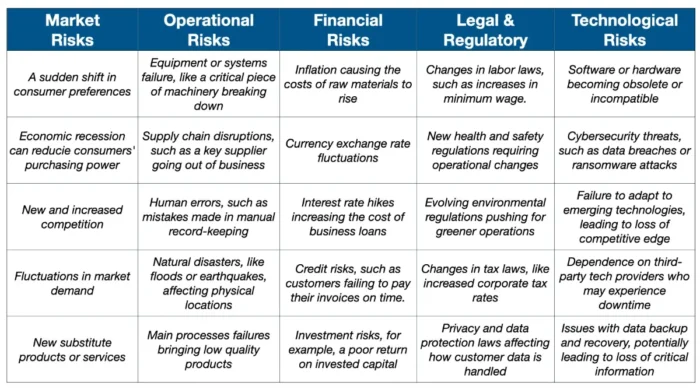
2. Risk Profiling
Conduct a detailed analysis of each identified risk, including its potential impact on your business objectives and the likelihood of occurrence. This will help you develop a comprehensive understanding of the risks you face.
Qualitative Risk Analysis
The qualitative risk analysis process involves assessing and prioritizing risks based on ranking or scoring systems to classify risks into low, medium, or high categories. For this analysis, you can use customer surveys or interviews.
Qualitative risk analysis is quick, straightforward, and doesn’t require specialized statistical knowledge to conduct a business risk assessment. The main negative side is its subjectivity, as it relies heavily on thinking about something or expert judgment.
This method is best suited for initial risk assessments or when there is insufficient quantitative analysis data .
For example, if we consider the previously identified risk of a sudden shift in consumer preferences, a qualitative analysis might rate its likelihood as 7 out of 10 and its impact as 8 out of 10, placing it in the high-priority quadrant of our risk matrix. But, qualitative analysis can also use surveys and interviews where you can ask open questions and use the qualitative research process to make this scaling. This is much better because you want to lower the subjectivism level when doing business risk assessment.
Quantitative Risk Analysis
On the other side, the quantitative risk analysis method involves numerical and statistical techniques to estimate the probability and potential impact of risks. It provides more objective and detailed information about risks.
Quantitative risk analysis can provide specific, data-driven insights, making it easier to make informed decisions and allocate resources effectively. The negative side of this method is that it can be time-consuming, complex, and requires sufficient data.
You can use this approachfor more complex projects or when you need precise data to inform decisions, especially after a qualitative analysis has identified high-priority risks.
For example , for the risk of currency exchange rate fluctuations, a quantitative analysis might involve analyzing historical exchange rate data to calculate the probability of a significant fluctuation and then using your financial data to estimate the potential monetary impact.
Both methods play crucial roles in effectively managing risks. Qualitative risk analysis helps to identify and prioritize risks quickly, while quantitative analysis provides detailed insights for informed decision-making.
3. Business Risk Assessment Matrix
Once you have identified potential risks and analyzed their likelihood and potential impact, you can create a business risk assessment matrix to evaluate each risk’s likelihood and impact. This matrix will help you prioritize risks and allocate resources accordingly.
A business risk assessment matrix, sometimes called a probability and impact matrix, is a tool you can use to assess and prioritize different types of risks based on their likelihood (probability) and potential damage (impact). Here’s a step-by-step process to create one:
- Step 1: Begin by listing out your risks . For our example, let’s consider four of the risks we identified earlier: a sudden shift in consumer preferences (Market Risk), currency exchange rate fluctuations (Financial Risk), an increase in the minimum wage (Legal), and cybersecurity threats (Technological Risk).
- Step 2: Determine the likelihood of each risk occurring . In the process of risk profiling, we’ve determined that a sudden shift in consumer preferences is highly likely, currency exchange rate fluctuations are moderately likely, an increase in the minimum wage, and cybersecurity threats are less likely but still possible.
- Step 3: Assess the potential impact of each risk on your business if it were to occur . In our example, we might find that a sudden shift in consumer preferences could have a high impact, currency exchange rate fluctuations a moderate impact, an increase in minimum wage minor impact, and cybersecurity threats a high impact.
- Step 4: Plot these risks on your risk matrix . The vertical axis represents the likelihood (high to low), and the horizontal axis represents the consequences (high to low).
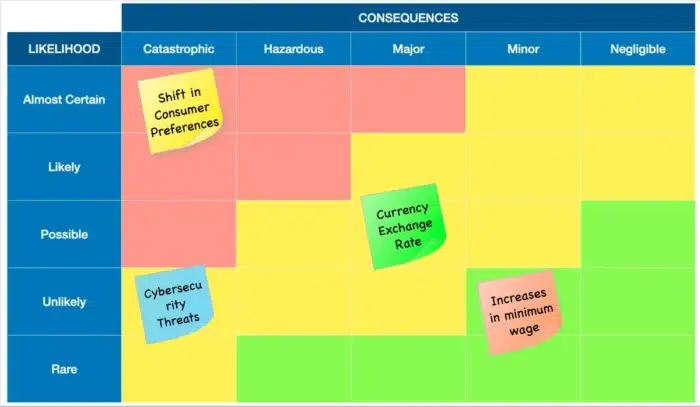
By visualizing these risks in a risk assessment matrix format, you can more easily identify which risks require immediate attention and which ones might need long-term strategies.
4. Develop Risk Indicators for Each Risk You Have Identified
The question is, how will you measure the business risks for your company?
Risk indicators are metrics used to measure and predict potential threats to your business. Simply, a risk indicator is a measure that should tell you whether the risk appears or not in a particular area you have defined previously. They act like a business’s early warning system. When these indicators change, it’s a signal that the risk level may be increasing.
For example, for distribution channels, an indicator can be a delay in delivery for a minimum of three days. This indicator will tell you something is wrong with that channel, and you must respond appropriately.
Now, let’s consider some risk indicators for the risks we have already identified and analyzed:
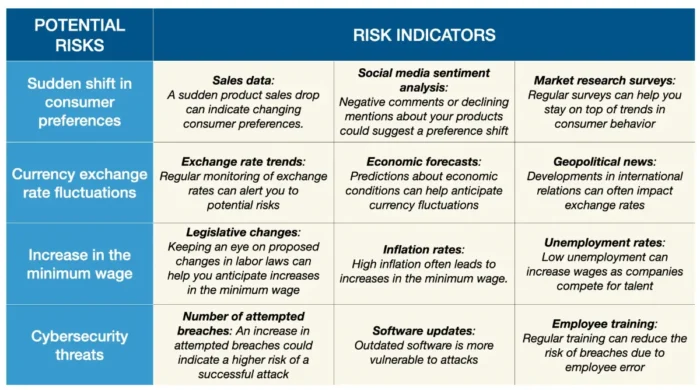
If you conduct all the steps until now, you can have a similar table with risk indicators in your business plan. You should monitor these indicators regularly, and if you notice a significant change, such as a drop in sales or an increase in attempted breaches, it’s time to investigate and take some action steps. This might involve updating your product line, hedging against currency risk, budgeting for higher wages, or improving your cybersecurity measures.
Remember, risk indicators can’t predict the future with certainty. But they can give you valuable insights that can help you prepare for potential threats.
5. Define Possible Action Steps
The question is, what can you do regarding the risk if the risk indicator tells you that there is a potential risk?
Once the risk has appeared and is located, it is time to take concrete action steps. The goals of this step are not only to reduce or eliminate the impact of the risk for your company but also to prevent them in the future and reduce or eliminate their influence on the business operations or the execution of your business plan.
For example, for distribution channels with delivery delayed more than three days, possible activities can be the following:
- Apologizing to the customers for the delay,
- Determining the reasons for the delay,
- Analysis of the reasons,
- Removing the reasons,
- Consideration of alternative distribution channels, etc.
In this part of the business plan for each risk area and indicator, try to standardize all possible actions. You can not expect that they will be final. But, you can cover some basic guidelines that must be implemented if the risk appears. Here is an example of how this part will look in your business plan related to risks we have already identified through the risk assessment process.
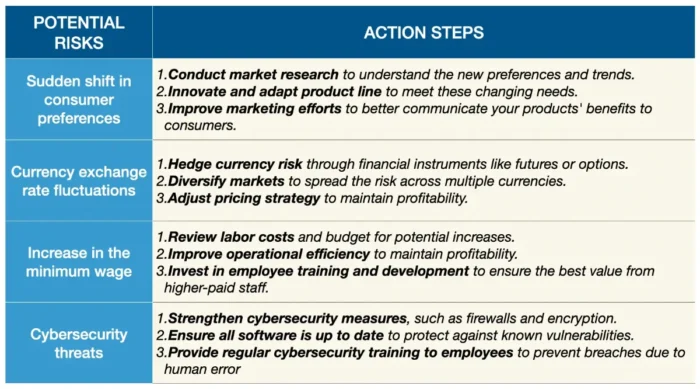
6. Monitoring
Because this risk management process is dynamic , you must apply the monitoring process. In such a way, you can ensure the elimination of a specific kind of risk in the future, and you will allocate your resources to new possible risks.
After implementing the actions, you need to ask yourself the following questions:
- Are the actions taken regarding the risk the proper measures?
- Can you improve something regarding the risk management process? Is there a need for new risk indicators?
Techniques and Tools for Business Plan Risk Assessment
Various risk analysis methods, techniques, and tools are available to conduct an effective risk analysis for your business plan. Here are some commonly used ones:
1. SWOT analysis
A SWOT (Strengths, Weaknesses, Opportunities, Threats) analysis can help you identify internal strengths and weaknesses and external opportunities and threats. This analysis provides valuable insights into possible business risks and opportunities.
2. PESTEL analysis
A PESTEL (Political, Economic, Sociocultural, Technological, Environmental, Legal) analysis assesses the external factors that could impact your business. This analysis will help you identify risks and opportunities arising from these factors.
3. Scenario analysis
Consider different scenarios that could impact your business, such as best-case, worst-case, and most likely scenarios, as a part of your risk assessment process. You can anticipate potential risks and develop appropriate response strategies by analyzing these scenarios.
4. Monte Carlo simulation
Monte Carlo simulation uses random sampling and probability distributions to model various scenarios and assess their potential impact on your business. This technique provides you with a more accurate understanding of risk exposure.
5. Risk register
A risk register is a risk analysis tool that helps you record and track identified risks and their relevant details, such as impact, likelihood, mitigation strategies, and responsible parties. This tool ensures that risks are appropriately managed and monitored.
6. Business Impact Analysis (BIA)
Business impact analysis helps you understand the potential effects of various disruptions on your business operations and objectives. It’s about identifying what could go wrong and understanding how it could impact your bottom line. So, you can conduct business impact analysis as a part of your risk assessment inside your business plan.
7. Failure Mode and Effects Analysis (FMEA)
Using FMEA in your risk assessment process, you can proactively address potential problems, ensuring your business operations run as smoothly as you planned. It’s all about preparing for the worst while striving for the best.
8. Risk-Benefit Analysis (RBA)
The risk-benefit analysis allows you to make informed decisions, balancing the potential for gain against the potential for loss. It helps you choose the best path, even when the way forward isn’t entirely clear. This tool is a systematic approach to understanding the specific business risk and benefits associated with a decision, process, or project.
9. Cost-Benefit Analysis
By conducting a cost-benefit analysis as a part of your risk assessments, you can make data-driven decisions that consider both the possible risks (costs) and rewards (benefits). This approach provides a clear picture of the potential return on investment, enabling more effective and confident decision-making.
These techniques and tools allow you to conduct a comprehensive risk analysis for your business plan.
Mitigating and Managing Risks in a Business Plan
Identifying risks in your business plan is only the first step. To ensure the success of your venture, it is crucial to develop effective risk mitigation and management strategies. Here are some critical steps to consider:
- Risk avoidance : Some risks may be too high to justify taking. In such cases, consider avoiding these risks altogether by adjusting your business plan or exploring alternative strategies.
- Risk transfer : Transferring risks to third parties, such as insurance companies or outsourcing partners, can help mitigate their impact on your business. Evaluate opportunities for risk transfer and consider appropriate insurance coverage.
- Risk reduction : Implement measures to reduce the likelihood and impact of identified risks. This may involve improving internal processes, implementing safety protocols, or diversifying your supplier base .
- Risk acceptance : Some risks may be unavoidable or negatively impact your business. In such cases, accepting the risks and developing contingency plans can help minimize their impact.
In conclusion, a comprehensive risk analysis is essential for identifying, assessing, and managing different types of risk that could impact your success.
Conducting a thorough risk analysis can safeguard your business’s interests, capitalize on opportunities, and increase your chances of long-term success.

Related Posts

How to Write a Business Plan in 36 Steps

Risk Tolerance in Entrepreneurship: A Guide to Successful Business

Business Goals Questions to Develop SMART Goals
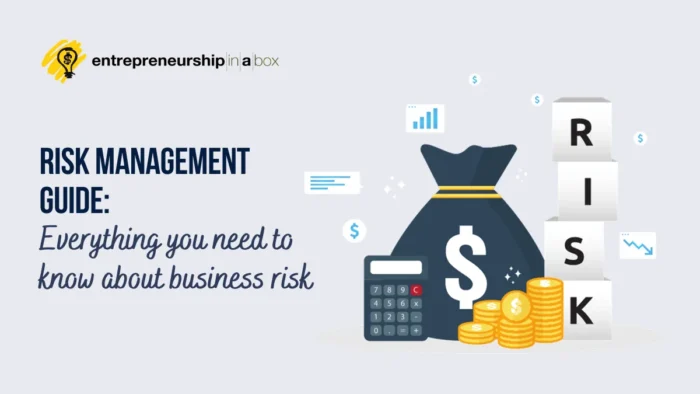
Risk Management Guide: Everything You Need to Know About Business Risk
Start typing and press enter to search.
- GLOBAL SEARCH
- WEB SUPPORT

13 Entrepreneurs Reveal The Platforms That Are Important For Marketing In the Next 5 Years

18 Entrepreneurs Share Essential Skills One Needs to be a CEO

16 Entrepreneurs Explain What Work Means to Them
25 entrepreneurs share essential skills one needs to be a ceo.

22 Entrepreneurs Share How They Incorporate Health and Fitness into Their Day

8 Entrepreneurs Reveal How Much They Work In a Week

11 Entrepreneurs Reveal Their Why/Motivation

12 Entrepreneurs Share Views on Whether Entrepreneurs are Born or Made

7 Entrepreneurs Share Essential Skills One Needs to be a CEO
- Wordpress 4 CEOs

How to Create a Google Business Profile / Tips to Optimize Google Business Profile

How to Get Your Product Into Walmart- {Infographic}

Make Money using Facebook – Make Great Posts

2 Interesting Updates from WordPress 4.8 Evans

How To Know If Your Business Idea Will Succeed

This is How to Write a Converting Email Autoresponder Series

15 Entrepreneurs Explain What They Love And/Or Hate About WordPress

6 Updates That I’m Paying Attention to with WordPress 4.7 – Vaughan

Download Our Free Guide

29 Entrepreneurs Reveal Their Best Leadership Tips

5 Entrepreneurs Share Their Favorite Business Books

18 Entrepreneurs and Business Owners Reveal Their Best Leadership Tips

30 Entrepreneurs Share Their Thoughts On the Role of Middle Management Within Organizations

7 Entrepreneurs Reveal Their Business Goals for 2024

27 Entrepreneurs List Their Favorite Business Books

14 Entrepreneurs Describe Their Leadership Style

30 Entrepreneurs Define The Term Disruption

25 Entrepreneurs Define Innovation And Disruption

16 Entrepreneurs Define The Term Disruption
- GUEST POSTS
- WEBSITE SUPPORT SERVICES
- FREE CBNation Buzz Newsletter
- Premium CEO Hack Buzz Newsletter

Business Plan 101: Critical Risks and Problems

When starting a business, it is understood that there are risks and problems associated with development. The business plan should contain some assumptions about these factors. If your investors discover some unstated negative factors associated with your company or its product, then this can cause some serious questions about the credibility of your company and question the monetary investment. If you are up front about identifying and discussing the risks that the company is undertaking, then this demonstrates the experience and skill of the management team and increase the credibility that you have with your investors. It is never a good idea to try to hide any information that you have in terms of risks and problems.
Identifying the problems and risks that must be dealt with during the development and growth of the company is expected in the business plan. These risks may include any risk related to the industry, risk related to the company, and risk related to its employees. The company should also take into consideration the market appeal of the company, the timing of the product or development, and how the financing of the initial operations is going to occur. Some things that you may want to discuss in your plan includes: how cutting costs can affect you, any unfavorable industry trends, sales projections that do not meet the target, costs exceeding estimates, and other potential risks and problems. The list should be tailored to your company and product. It is a good idea to include an idea of how you will react to these problems so your investors see that you have a plan.
Related Posts

Business Plan 101: Overall Schedule
Business plan 101: personal financial statement.

This Teach a CEO focuses on Google Business Profile formerly Google My Business. List your business on Google with a...

How can you get your products into Walmart? Many entrepreneurs struggle with the lack of ideas on where exactly they...

As we know that ‘Content is the King’, therefore, you must have an ability to write and share good quality...

WordPress 4.8 is named "Evans" in honor of jazz pianist and composer William John “Bill” Evans. There's not a log of...

Business Plan 101: Financial History
Leave a reply cancel reply.
Your email address will not be published. Required fields are marked *
Privacy Policy Agreement * I agree to the Terms & Conditions and Privacy Policy .
This site uses Akismet to reduce spam. Learn how your comment data is processed .
Join CBNation Buzz

Our Latest CBNation Content:
- IAM2228 – Holistic Dietitian Nutritionist and Founder Passionate About Encouraging Wellness Through Knowledge
- IAM2227 – Certified Personal Trainer Helps Clients Achieve Success in Health and Fitness Through Mindset Change
- IAM2226 – CEO Specializes in Developing Unique Solutions in the Pharmaceutical Industry
- Founder and Author Shares His Insights On Effective Leadership and Embracing Curiosity
- CEO and Founder Discusses the Evolution of Public Relations and the Importance of Storytelling in Business
- Founder and Coach Shares on How to Master Relationship-Building in Business
Our Sponsors
Join thousands of subscribers & be the first to get new freebies.

What is CBNation?
We're like a global business chamber but with content... lots of it.
CBNation includes a library of blogs, podcasts, videos and more helping CEOs, entrepreneurs and business owners level up
CBNation is a community of niche sites for CEOs, entrepreneurs and business owners through blogs, podcasts and video content. Started in much the same way as most small businesses, CBNation captures the essence of entrepreneurship by allowing entrepreneurs and business owners to have a voice.
CBNation curates content and provides news, information, events and even startup business tips for entrepreneurs, startups and business owners to succeed.
+ Mission: Increasing the success rate of CEOs, entrepreneurs and business owners.
+ Vision: The media of choice for CEOs, entrepreneurs and business owners.
+ Philosophy: We love CEOs, entrepreneurs and business owners and everything we do is driven by that. We highlight, capture and support entrepreneurship and start-ups through our niche blog sites.
Our Latest Content:
- IAM2225 – CEO Shares on How to Find Joy and Fulfillment in Leadership
- IAM2224 – CEO and Real Estate Investor Stresses the Importance of Creativity and Multiple Streams of Income
- IAM2223 – Fractional CMO Transforms Businesses with Holistic Marketing Strategies
- IAM2222 – CEO and E-Commerce Expert Utilizes AI Tools for Business Growth and Leadership

Privacy Overview
- Teach A CEO
Share on Mastodon
This free Notion document contains the best 100+ resources you need for building a successful startup, divided in 4 categories: Fundraising, People, Product, and Growth.

This free eBook goes over the 10 slides every startup pitch deck has to include, based on what we learned from analyzing 500+ pitch decks, including those from Airbnb, Uber and Spotify.

This free sheet contains 100 accelerators and incubators you can apply to today, along with information about the industries they generally invest in.

This free sheet contains 100 VC firms, with information about the countries, cities, stages, and industries they invest in, as well as their contact details.

This free sheet contains all the information about the top 100 unicorns, including their valuation, HQ's location, founded year, name of founders, funding amount and number of employees.

12 Types of Business Risks and How to Manage Them
Description

Everything you need to raise funding for your startup, including 3,500+ investors, 7 tools, 18 templates and 3 learning resources.

Information about the countries, cities, stages, and industries they invest in, as well as their contact details.

List of 250 startup investors in the AI and Machine Learning industries, along with their Twitter, LinkedIn, and email addresses.

List of startup investors in the BioTech, Health, and Medicine industries, along with their Twitter, LinkedIn, and email addresses.

List of startup investors in the FinTech industry, along with their Twitter, LinkedIn, and email addresses.
90% of startups fail .
Thanks to the explosion of the digital economy, business founders have plenty of opportunities that they can tap into to build a winning business.
Unfortunately, there is a myriad of challenges your new business has to navigate through. These risks are inevitable, and they are a part of life in the business world.
However, without the right plan, strategy, and instruments, your business might be drowned by these challenges.
Therefore, we have created this guide to show you how can your business utilize risk management to succeed in 2022.
There are many types of startup and business risks that entrepreneurs can expect to encounter in 2022. Most of these threats are prevalent in the infancy stages of a business.
To know what you’ll be up against, here is a breakdown of the 12 most common threats.
12 Business Risks to Plan For
1) economic risks.
Failure to acquire adequate funding for your business can damage the chances of your business succeeding.
Before a new business starts making profits, it needs to be kept afloat with money. Bills will pile up, suppliers will need payments, and your employees will be expecting their salaries.
To avoid running into financial problems sooner or later, you need to acquire enough funds to shore up your business until it can support itself.
On the side, world and business country's economic situation can change either positively or negatively, leading to a boom in purchases and opportunities or to a reduction in sales and growth.
If your business is up and running, a great way to limit the effect of negative economic changes is to maintain steady cash flow and operate under the lean business method.
Here's an article from a founder explaining how he set up a lean budget on his $400k/year online business.
2) Market Risks
Misjudging market demand is one of the primary reasons businesses fail .
To avoid falling into this trap, conduct detailed research to understand whether you will find a ready market for what you want to sell at the price you have set.
Ensure your business has a unique selling point, and make sure what you offer brings value to the buyers.
To know whether your product will suit the market, do a survey, or get opinions from friends and potential customers.
Building a Minimum Viable Product of that business idea you've had is the recommendations made by most entrepreneurs.
This site, for example, was built in just 3 weeks and launched into the market to see if there was any interest in the type of content we offered.
The site was ugly, had little content and lacked many features. Yet, +7,700 users visited it within the first week, which made us realize we should keep working on this.

90% of startups fail. Learn how to not to with our weekly guides and stories. Join 40,000+ founders.
3) Competitive Risks
Competition is a major business killer that you should be wary of.
Before you even start planning, ask yourself whether you are venturing into an oversaturated market.
Are there gaps in the market that you can exploit and make good money?
If you have an idea that can give you an edge, register it. This will prevent others from copying your product, re-innovating it, and locking you out of what you started.
Competitive risks are also those actions made by competitors that prevent a business from earning more revenue or having higher margins.
4) Execution Risks
Having an idea, a business plan, and an eager market isn’t enough to make your startup successful.
Most new companies put a lot of effort into the initial preparation and forget that the execution phase is equally important.
First, test whether you can develop your products within budget and on time. Also, check whether your product will function as intended and whether it’s possible to distribute it without taking losses.
5) Strategic Risks
Business strategies can lead to the growth or decline of a company.
Every strategy involves some risk, as time & resources are generally involved to put them into practice.
Strategic risk in the chance that an implemented strategy, therefore, results in losses.
If, for example, the Marketing Department of a company implements a content marketing strategy and a lot of months, time & money later the business doesn't see any ROI, this becomes a strategic risk.
6) Compliance Risks
Compliance risks are those losses and penalties that a business suffers for not complying with countries' and states' regulations & laws.
There are some industries that are highly-regulated so the compliance risks of businesses within them are super high.
For example, in May 2018, the EU Commission implemented the General Data Protection Regulation (GDPR), a law in privacy and data protection in the EU, which affected millions of websites.
Those websites that weren't adapted to comply with this new rule, were fined.
7) Operational Risks
Operational risks arise when the day-to-day running of a company fail to perform.
When processes fail or are insufficient, businesses lose customers and revenue and their reputation gets ruined.
One example can be customer service processes. Customers are becoming every day less willing to wait for support (not to mention, receive bad quality one).
If a business customer service team fails or delays to solve customer's issues, these might find their solution in the business competitors.
8) Reputational Risks
Reputational risks arise when a business acts in an immoral and discourteous way.
This led to customer complaints and distrust towards the business, which means for the company a big loss of sales and revenue.
With the rise of social networks, reputational risks have become one of the main concerns for businesses.
Virality is super easy among Twitter so a simple unhappy customer can lead to a huge bad press movement for the company.
A recent example is the Away issue with their toxic work environment, as a former employee reported in The Verge .
The issue brought lots of critics within social networks which eventually led the CEO, Steph Korey, to step aside from the startup ( she seems to be back, anyway 🤷♂️! ).
9) Country Risks
When a business invests in a new country, there is a high probability it won't work.
A product that is successful in one market won't necessarily be in another one, especially when people within them are so different in cultures, climates, tastes backgrounds, etc.
Country risk is the existing failure probability businesses investing in new countries have to deal with.
Changes in exchange rates, unstable economic situations and moving politics are three factors that make these country risks be even more delicate.
10) Quality Risks
When a business develops a product or service that fails to meet customers' needs and quality expectations, the chance these customers will ever buy again is low.
In this way, the business loses future sales and revenue. Not to mention that some customers will ask for refunds, increasing business costs, as well as publicly criticize the company's products, leading to bad reputation (and a viral cycle that means even less $$ for the business).
11) Human Risk
Hiring has its benefits but also its risks.
Employees themselves involve a huge risk for a business, as they become to represent the company through how they work, mistakes committed, the public says and interactions with customers & suppliers,
A way to deal with human risk is to train employees and keep a motivated workforce. Yet, the risk will continue to exist.
12) Technology Risk
Security attacks, power outrage, discontinued hardware, and software, among other technology issues, are the events that form part of the technology risk.
These issues can lead to a loss of money, time and data, which has many connections with the previously mentioned risks.
Back-ups, antivirus, control processes, and data breach plans are some of the ways to deal with this risk.
How Businesses Can Use Risk Management To Grow Business
To mitigate any future threats, you need to prepare a comprehensive risk management plan.
This plan should detail the strategy you will use to deal with the specific challenges your business will encounter. Here’s what to do.
1) Identify Risks
Every business encounters a different set of challenges.
Before mapping the risks, analyze your business and note down its key components such as critical resources, important services or products, and top talent.
2) Record Risks
Once risks have been identified, you need to assess and document the threats that can affect each component.
Identify any warning signs or triggers of that recorded risk, also.
3) Anticipate
The best way to beat a threat is to detect and prepare for it in advance.
Once you know your business can be affected by a certain scenario, develop steps that you will take to stop the risk or to blunt its effects.
4) Prioritize Risks
Not all types of business risk have the same effect. Some can bring your startup to its knees, while others will only cause minimal effects.
To keep your business alive, start by putting in place measures that protect the vital functions from the most severe and most probable risks.
5) Have a Backup Plan
For every risk scenario, have at least two plans for countering the threat before it arrives.
The strategy you put in place should be in line with the current technology and trends.
Ensure your communicate these measures with all your team members.
6) Assign Responsibilities
When communicating measures with the team, assign responsibilities for each member in case any of the recorded risks affect the business.
These members should also be responsible for controlling the risks every certain time and maintaining records about them.
What is a Business Risk?
The term "business risk" refers to the exposure businesses have to factors that can prevent them from achieving their set financial goals.
This exposure can come from a variety of situations, but they can be classified into two:
- Internal factors: The risk comes from sources within the company, and they tend to be related to human, technological, physical or operational factors, among others.
- External factors: The risk comes from regulations/changes affecting the whole country/economy.
Any of these factors led to the business being unable to return investors and stakeholders the adequate amounts.
What Is Risk Management?
Risk management is a practice where an entrepreneur looks for potential risks that their business may face, analyzes them, and takes action to counter them.
The steps you take can eliminate the threat, control it, or limit the effects.
A risk is any scenario that harms your business. Risks can emanate from a wide variety of sources such as financial problems, management errors, lawsuits, data loss, cyber-attacks, natural calamities, and theft.
The risk landscape changes constantly, therefore you need to know the latest threats.
By setting up a risk management plan, your business can save money and time, which in some cases can be the determinant to keep your startup in business.
Not to mention, on the side, that risk management plans tend to make managers feel more confident to carry out business decisions, especially the risky ones, which can put their startups in a huge competitive advantage.
Wrapping Up
Becoming your own boss is one of the most rewarding things you can do.
However, launching a business is not a walk in the park; risks and challenges lurk around every corner.
If you are planning to establish a new business come 2022, make sure you secure its future by creating a broad risk management plan.

90% of startups fail. Learn how not to with our weekly guides and stories. Join +40,000 other startup founders!
An all-in-one newsletter for startup founders, ruled by one philosophy: there's more to learn from failures than from successes.
100+ resources you need for building a successful startup, divided into 4 categories: Fundraising, People, Product, and Growth.
- Business Ideas
- Startup Plans
- Advertising
6 Critical Risks in a Business Plan
- by Olaoluwa
- November 8, 2023 August 28, 2024
Business Plan Risks Analysis, Problem, Challenging Factors and Mitigation Strategies
What is a major example of critical risk in a business plan? Every business is prone to facing certain business risks, which might appear very critical in the real world.
As a business person, you must be able to spend sufficient time in drafting your business plan so that it is capable of addressing the critical risks and assumptions that your business might face.
You should be able to envision and determine, in your business plan, critical risks in a restaurant business plan that might pose a threat to the overall success of your business. When you do not pay enough attention to these risks, it could cause your readers – most important of which are potential investors and bankers – to negatively evaluate your business plan.
Below are some critical business risks and contingencies in a business plan that you must ensure to properly handle before they pose a threat to the success of your business.
Conducting Business Plan Risk Assessment – Business Plan Risk Factors
• Risk of Overestimated Figures
The number one critical business risk that might land your business into problem by getting too much negative attention has to do with figures that have been overestimated. We are talking about high sales profit that seem too optimistic; salaries that appear to be too high or outrageous for a business of its age; and profitability. These three, if you overestimate the figures, will inadvertently pose as a serious business risk.
For salaries, it will be wise for you to go for the minimum as a startup business, together with any additional incomes that come in the form of profits.
For sales and profits, it will be wise of you to always give figures that appear to be more likely, not figures that seem to match your optimism. Your business’ profitability largely depends on your ability to meet sales projections, and your ability to be able to operate in the confines of your costs. • Risk of Indecisive Conversion Rates
Conversion rate (also hit rate) has to do with the percentage of people, out of the total number of people you approached, that purchased or patronized your product or services. Conversion rate could be best tested through test marketing or pre-selling.
When you test market, it simply means you offer the sales of your product within a particular limited area, for a particular period of time. Usually, you would offer incentives to buyers to encourage them help you outline your actual target customers for your business.
When you pre-sell, you are making introduction of your products or services to prospective customers, and even accepting orders for deliveries.
Your goal is to accurately know the conversion rate such that a reader may be able to take your projected market size, apply the conversion rate, and be able to deduce what the total sales estimate might be. • Risk of Ignored Competition
Here is another critical business risk that many entrepreneurs fail to curtail. As an entrepreneur, you are the master and captain of your game. You are to take charge and seize your market. How do you do that? You are to know every competitor in the industry of your business. Yes, it is an obligation you can never overlook.
Many entrepreneurs feel they know their competitors very well, when in actually reality, they have no real clue as to who their major competitors are. You must ensure you have adequate knowledge of your immediate competitors, as well as substitutes and potential or latent competitors.
If you want to prove your long-term vision for your business, you must always keep abreast with the latest development regarding your competitors. You should even envision businesses that, in later years, might stand as competitors.
• Financial Risk
Most businesses today fold up as a result of financial difficulties. Lack of adequate financial resources is a very critical business risk that might make a business to close.
In most cases, the business runs out of enough money; many customers are taking too long to pay up; unforeseen expenses and too much miscellaneous; accidents and costly financial mistakes could pose a very critical business risk to the business, and even lead to the eventual folding up if the business does not have enough money saved for rainy days to handle such problems.
In your business plan, you should demonstrate that you have adequate financial strength to operate your business until break-even and even after that. Provide the amount of needed investments and loans you will obtain to start and even run the business successfully – even if you are sure your sales volume will generate as much needed money to run the business.
• Risk of Inadequate Payback
When drafting your business plan, it is pertinent to always think about what the readers of your business plan will be expecting. For most people, it is how you intend to pay back the loan or investment you obtained, or the line of credit you hope to obtain from external sources such as banks.
For bankers, they would analyze the business plan critically to understand how exactly you have made plans to settle up the loans or line of credit you want to obtain from the bank. Your cash flows and your collateral issues are highly significant.
In the case of investors, the growth rates and profit margins of the business are highly critical because these are the factors that will actually determine how much they would earn.
For very vital employees, analyzing the business plan helps them have a good grasp of the business’ operation; this in turn would help them envision their future with the business. • Strategic Risk
Another critical business risk factor to your business plan is the strategic risk. Sometimes, your best well-laid business plan might very quickly, actually look so obsolete.
The strategic risk is the business risk that your business strategy might actually become too rigid and no longer efficient in shooting your business to its desired level; your business then starts struggling in order to achieve its business goals.
This business risk could be as a result of a very powerful new competitor in the industry; technological advancement; a shift in the demand of customers; or even a rise in the cost of raw materials or other market changes.
You should take out time to write your business plan such that whenever you face a strategic risk, you should be able to easily tweak your business strategy and adapt, and be able to come up with a viable solution.
Related Posts
- How To Start Transportation Business
- How To Start Food Business
- How To Start Healthcare Business
- How to Make Money From Business Plan
- How To Start Financial Service Business
Leave a Reply Cancel reply
Your email address will not be published. Required fields are marked *
How to Highlight Risks in Your Business Plan

Tallat Mahmood
5 min. read
Updated October 25, 2023

One of the areas constantly dismissed by business owners in their business plan is an articulation of the risks in the business.
This either suggests you don’t believe there to be any risks in your business (not true), or are intentionally avoiding disclosing them.
Either way, it is not the best start to have with a potential funding partner. In fact, by dismissing the risks in your business, you actually make the job of a lender or investor that much more difficult.
Why a funder needs to understand your business’s risks:
Funding businesses is all about risk and reward.
Whether it’s a lender or an investor, their key concern will be trying to balance the risks inherent in your business, versus the likelihood of a reward, typically increasing business value. An imbalance occurs when entrepreneurs talk extensively about the opportunities inherent in their business, but ignore the risks.
The fact is, all funders understand that risks exist in every business. This is just a fact of running a business. There are risks that exist with your products, customers, suppliers, and your team. From a funder’s perspective, it is important to understand the nature and size of risks that exist.
- There are two main reasons why funders want to understand business risks:
Firstly, they want to understand whether or not the key risks in your business are so fundamental to the investment proposition that it would prevent them from funding you.
Some businesses are not at the right stage to receive external funding and placate funder concerns. These businesses are best off dealing with key risk factors prior to seeking funding.
The second reason why lenders and investors want to understand the risk in your business is so that they can structure a funding package that works best overall, despite the risk.
In my experience, this is an opportunity that many business owners are wasting, as they are not giving funders an opportunity to structure deals suitable for them.
Here’s an example:
Assume your business is seeking equity funding, but has a key management role that needs to be filled. This could be a key business risk for a funder.
Highlighting this risk shows that you are aware of the appointment need, and are putting plans in place to help with this key recruit. An investor may reasonably decide to proceed with funding, but the funding will be released in stages. Some will be released immediately and the remainder will be after the key position has been filled.
The benefit of highlighting your risks is that it demonstrates to investors that you understand the danger the risks pose to your company, and are aware that it needs to be dealt with. This allows for a frank discussion to take place, which is more difficult to do if you don’t acknowledge this as a problem in the first place.
Ultimately, the starting point for most funders is that they want to invest in you, and want to validate their initial interest in you.
Highlighting your business risks will allow the funder to get to the nub of the problem, and give them a better idea of how they may structure their investment in order to make it work for both parties. If they are unsure of the risks or cannot get clear explanations from the team, it is unlikely they will be forthcoming when it comes to finding ways to make a potential deal work.
Brought to you by
Create a professional business plan
Using ai and step-by-step instructions.
Secure funding
Validate ideas
Build a strategy
- The right way to address business risks:
The main reason many business owners don’t talk about business risks with potential funders is because they don’t want to highlight the weaknesses in their business.
This is a fair concern to have. However, there is a right way to address business risk with funders, without turning lenders and investors off.
The solution is to focus on how you mitigate the risks.
In other words, what are the steps you are taking in your business as a direct reaction to the risks that you have identified? This is very powerful in easing funder fears, and in positioning you as someone who has a handle on their business.
For example, if a business risk you had identified was a high level of customer concentration, then a suitable mitigation plan would be to market your products or services targeting new clients, as opposed to focusing all efforts on one client.
Having net profit margins that are lower than average for your market would raise eyebrows and be considered a risk. In this instance, you could demonstrate to funders the steps you are putting in place over a period of time to help increase those margins to at least market norms for your niche.
The process of highlighting risks—and, more importantly, outlining key mitigating actions—not only demonstrates honesty, but also a leadership quality in solving the problems in your business. Lenders and investors want to see both traits.
- The impact on your credibility:
Any lender or investor backs the leadership team of a business first, and the business itself second.
This is because they realize that it is you, the management team, who will ultimately deliver value and grow the business for the benefit for all. As such, it is imperative that they have the right impression about you.
The consequence of highlighting business risks in your business plan with mitigations is that it provides funders a real insight into you as a business leader. It demonstrates that not only do you have an understanding of their need to understand risk in your business, but you also appreciate that minimizing that risk is your job.
This will have a massive impact on your credibility as a business owner and management team. This impact is more acute when compared to the hundreds of businesses they will meet that omit discussing the risks in their business.
The fact is, funders have seen enough businesses and business plans in all sectors to instinctively know what risks to expect. It’s just more telling if they hear it from you first.
- What does this mean for you going forward?
Funders rely on you to deliver on your inherent promise to add value to your business for all stakeholders. The weight of this promise becomes much stronger if they can believe in the character of the team, and that comes from your credibility.
A business plan that discusses business risks and mitigations is a much more complete plan, and will increase your chances of securing funding.
Not only that, but highlighting the risks your business faces also has a long-term impact on your character and credibility as a business leader.
Tallat Mahmood is founder of The Smart Business Plan Academy, his flagship online course on building powerful business plans for small and medium-sized businesses to help them grow and raise capital. Tallat has worked for over 10 years as a small and medium-sized business advisor and investor, and in this period has helped dozens of businesses raise hundreds of millions of dollars for growth. He has also worked as an investor and sat on boards of companies.

Table of Contents
- Why a funder needs to understand your business’s risks:
Related Articles

8 Min. Read
How to Forecast Personnel Costs in 3 Steps

5 Min. Read
9 Common Mistakes with Business Financial Projections

How to Improve the Accuracy of Financial Forecasts

11 Min. Read
How to Create a Sales Forecast
The LivePlan Newsletter
Become a smarter, more strategic entrepreneur.
Your first monthly newsetter will be delivered soon..
Unsubscribe anytime. Privacy policy .

The quickest way to turn a business idea into a business plan
Fill-in-the-blanks and automatic financials make it easy.
No thanks, I prefer writing 40-page documents.

Discover the world’s #1 plan building software

Strategic Risk Management: Complete Overview (With Examples)

As businesses continue to operate in an increasingly competitive and uncertain environment exacerbated by threats to their operations, such as cyberattacks, supply chain disruptions, and climate catastrophes, strategic risk management has become a key factor in ensuring an organization's success.
According to Racounteur , 85% of business leaders feel they are operating in a moderate to high-risk environment, and 79% of boards believe that improved risk management will be critical in enabling their organization to protect and build value in the next five years.
It's clear that organizations need to be prepared for the different types of strategic risk coming their way and have strong strategic risk management in place to not only reduce the impact on their operations but even take advantage of the context and transform it into an opportunity.
In this article, we'll dive into the world of strategic risk, the different types of strategic risks, and how to manage them to reduce the chances of disruption. We'll also give you real-life examples and a ready-to-use, free Risk Management Template to help your business be in strategic control and start your journey toward effective strategic risk management.
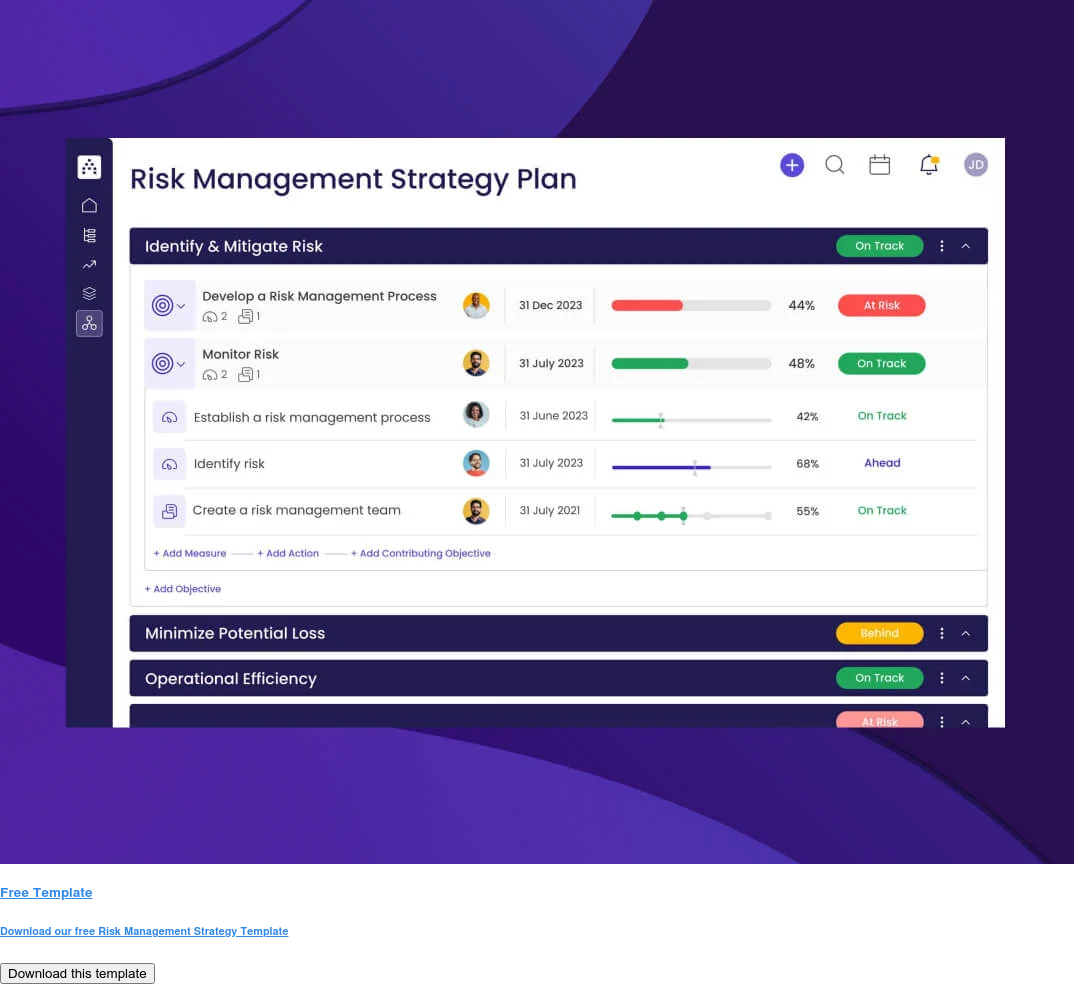
What Is Strategic Risk?
Strategic risk is the probability of the organization’s strategy failing. It is an estimation of the future success of the chosen strategy. Since strategy is a set of clear decisions, strategic risk reflects the aggregate of the risks of those decisions.
At its core, strategic risks affect an organization's overall strategy . It can sometimes be difficult to spot and manage.
This means that particularly at an executive level, leaders and teams need to be able to look for strategic risks and, instead of categorizing them as things to hedge or mitigate, develop the acumen to ask the appropriate questions:
- Are we going to resist this, avoid it, or maybe push it away?
- Or do we embrace it, use it as an indicator for the market and take it as an opportunity for a strategic change?
🤓Want to learn more? Download our FREE Strategic Risk Guide (PDF) with examples, definitions, and a clear framework to help you and your organization better manage strategic risk.
What Is Strategic Risk Management?
Strategic risk management is the process of recognizing risks, identifying their causes and effects, and taking the relevant actions to mitigate them. Risks arise from inside and outside factors such as manufacturing failures, economic changes, shifts in consumer tastes, etc.
Strategic risk can disrupt a business’s ability to accomplish its goals , break out in the market or even survive. Effective, efficient management puts the power in leaders’ hands to avoid potential obstacles to success and maximize their performance.
Why Is Strategic Risk Management Important?
Organizations that fail to do proper risk management face significant threats. At times, they face existential threats. Kodak was a pioneer in the photography space (they actually filed a patent for one of the first digital cameras), but they lost the digital camera race . Blockbuster made $6 billion in revenue at its peak, but there is only one store left in the world ! MySpace was once one of the dominant social networks until Facebook came along .
You could argue that these companies failed to innovate. Maybe, but they also failed to evaluate the threat properly and the risk involved in not dealing with it.
Every great company takes risks.
Smartphones, eReaders, car-sharing services, even natural cleaning products — so much of what we as consumers now take for granted was a brave step, once upon a time. But Apple , Amazon , Zipcar, and Method didn’t launch their category-defining products overnight.
These organizations safeguarded their success with a strong risk management strategy. They knew what success would look like, which factors could cause them to fail, what failure could cost them, and how they would respond to obstacles in their path.
Managing strategic risk is an essential activity for all businesses, whether you’re launching an innovative solution to market or just trying to stay ahead of the competition.
Understanding the dangers (however small) and their potential impact (however minor) empowers leaders at different levels to make smart, well-informed decisions.
But that’s easier said than done. Risk management is a dynamic process - it shifts focus as internal and external influences change. It also requires joined-up thinking and communication across an organization.
If you’re tasked with strategic planning and execution within your business, it can seem like an insurmountable task. Yet, armed with the right information, you can help ensure that your organization achieves its goals.
The Two Kinds Of Strategic Risk Factors
One of the first things you need to do to better manage risks is learn to identify them. There are mainly 2 kinds of strategic risk factors that you should look out for.
1. Internal strategic risk factors
Every business has strategic objectives and established routines.
Strategic risk relates to the dangers companies face in trying to accomplish their strategic objectives. Even though your plan might seem viable and on track for success, analyzing the strategic risks involved can help organizations identify obstacles (or opportunities)—and address them before it’s too late.
Strategic risks relate to a business’s internal choices, such as product development routines, advertising, communication tools, sales processes, investments in cutting-edge technologies, and more. These examples all directly impact function, performance, and overall results.
2. External strategic risk factors
Some strategic risks originate outside the company.
These could apply to the current or projected environment into which products will be released.
It’s often easier to understand strategic risk through real-world examples. For instance, a new type of smartphone might be in high demand today, but economic changes could lead to a drop in commercial interest, leaving the business in a totally different position than it might have expected.
Or a competitor may release a groundbreaking product or innovative service that fills the gap first, creating significant risk to the success of a strategy.
And let’s not forget that technology’s swift evolution could cause a new product to become obsolete within a few months—I’m sure that the manufacturers of wired headphones felt their stomachs drop when they saw Apple had cut the headphone jack.
These types of risks pose a real danger to companies. Investing in a business model with little chance of achieving the envisioned success can lead to severe financial strain, loss of revenue, and damage to reputation.
And none of these are easy to recover from.
Strategic Risk Assessment: How To Identify Strategic Risks?
Recognizing and taking action on strategic risks is vital to mitigate costly problems.
In your strategic risk management toolkit, you’ll need two essentials:
- An in-depth understanding of where your organization stands . This includes your target audience, market sector, competitors, and the environment in which your business operates.
- A clear awareness of your organization’s core strategic goals , from conception to proposed execution .
Gathering data on both areas can take time and investment, but it’s worthwhile to achieve accurate insights into strategic risks.
The more information you have to draw upon, the more likely it is that you’ll be able to implement processes and safeguards that facilitate organizational success.
Teams have a choice of different approaches when identifying strategic risks.

Initiate “What if” discussions
Gather employees from across the business to explore ‘what-if’ scenarios .
By mind mapping risk factors collaboratively —with a mix of perspectives and experiences from different departments—Heads of Strategy, Change Managers, and Business Analysts may discover risks they wouldn’t have thought of on their own.
All potential risks are worth considering, no matter how unlikely they may seem at first. That’s why participants should be encouraged to let their minds wander and suggest virtually any viable risk that occurs to them.
It’s best to have a long list that can be reduced through elimination: underestimating risks can lead to businesses being unprepared down the line.
📚 Recommended reading: Risk Matrix: How To Use It In Strategic Planning
Gather input from all stakeholders
Speak with the whole range of stakeholders and consider their views on strategic risks.
If you consult a wide enough group, you’ll gather expanded perspectives about your organization or issues and not just the ones from your core employees.
Collecting a wide range of perspectives creates a holistic view of risk factors which can prove hugely beneficial when trying to understand the dangers the organization faces.
Their broad awareness of how the company operates can raise unexpected possibilities that need to be factored in.
Strategic Risk Examples
The specific strategic risks relevant to your business will largely depend on your industry, sector, product range, consumer base, and many other factors. That being said, there are some broad types of strategic risk, each of which should be on your radar.

Regulatory risks
Let’s demonstrate the importance of regulatory risks with an example.
Imagine an organization working on a new product or planning a fresh service set to transform the market. Perhaps it spots a gap in the industry and finds a way to fill it, yet needs years to bring it to fruition.
However, in this time, regulations change and the product or service suddenly becomes unacceptable. The company can’t deliver the result of its hard work to the target audience, risking a substantial loss of revenue.
Fortunately, the organization had prepared for unexpected regulatory change. Now, elements of the completed project can be incorporated into another or adapted to offer a slightly different solution.
The lesson here?
It’s vital for companies to stay updated on all regulations relevant to their market and be aware of upcoming changes as early as possible.
Competitor risks
Most industries are fiercely competitive. Companies can lose ground if their market rivals release a similar product at a similar or lower cost. Pricing may even be irrelevant if the product is suitably superior.
Competitor analysis can help mitigate this strategic risk: businesses should never operate in a vacuum.
📚 Recommended read: 6 Competitive Analysis Frameworks: How to Leave Your Competition In the Dust
Economic risks
Economic risks are harder to predict, but they pose a real danger to even the most well-realized strategy. For example, economic changes can lead a business’s target audience to lose much of its disposable income or scale back on perceived luxuries.
Customer research is imperative to stay aware of what target audiences desire, their spending habits, lifestyles, financial situations, and more.

Change risks
Change risks refer to the challenges that arise from changes in technology, market trends, consumer preferences, or industry standards.
For instance, a company heavily invested in a particular technology may face significant risks if a disruptive innovation renders their current technology obsolete. Having a strong change management strategy to adapt to change and embracing innovation are key strategies to mitigate this risk.
Reputational risks
Reputational risks arise when a company's actions or associations damage its brand image and public perception. Negative publicity, customer dissatisfaction, product recalls, or ethical controversies can all contribute to reputational risks.
Safeguarding the company's reputation through transparent communication, ethical practices, and proactive crisis management is crucial.
Governance risks
Governance risks refer to the effectiveness and integrity of a company's management and decision-making processes. Weak corporate governance, lack of oversight, non-compliance with regulations, or unethical behavior by key executives can lead to significant strategic risks.
Establishing robust governance frameworks, maintaining transparency, and fostering a culture of accountability are essential to mitigate these risks.
Political risks
Political risks stem from changes in government policies, regulations, or geopolitical events. These risks can impact businesses operating domestically or internationally. Political instability, trade restrictions, sanctions, or changes in tax policies can disrupt operations and affect profitability.
Companies must closely monitor political developments and have contingency plans to navigate such risks effectively.
Financial risks
Financial risks involve challenges related to capital management, funding, cash flow, and financial stability. Factors such as market volatility, credit risks, liquidity constraints, or inadequate financial planning can expose a company to strategic risks.
Implementing sound financial strategies, conducting risk assessments, and maintaining a healthy balance sheet are crucial in managing these risks effectively.
Operational risks
Operational risks are inherent in day-to-day business activities and processes. These risks encompass issues such as supply chain disruptions, equipment failures, cybersecurity breaches, human errors, or natural disasters.
Ensuring robust operational processes, implementing contingency plans, and investing in risk mitigation measures can help minimize the impact of operational risks.
Managing Strategic Risk Vs. Operational Risk
Strategic risks and operational risks are two distinct kinds. While strategic risks originate from both internal and external forces, operational risks stem solely from the internal processes within a business and they stand to disrupt workflow.
However, the biggest difference between them is the level of the decisions they reflect.
Strategic risks reflect the risk of the decisions at a higher level, where the overall strategic plan is considered. The operational risks reflect the risk of the decisions at a lower level, the operational level, where the execution of the strategic plan is outlined.
Simply put, strategic risk is about what you do, and operational risk is how you do it.
Operational risks examples
Operational risks are critical to consider and must be dealt with as soon as possible. They directly impact a business’s work and can tie in with strategic risks, as the resources, processes, or staff available may be unable to achieve the established goals.
One example of operational risk is outdated machinery. They can cause a slowdown in production, delay completion, and ultimately damage employee morale. In this case, the operational risk might stem from what appears to be a non-critical problem but has the potential to drag productivity down to rock bottom. So the decision of whether to upgrade the machinery should be considered.
Another example of operational risk is a company’s current payroll system. Let’s say they outsource to a small team with a weak reputation purely because it’s a cheaper alternative to working with a more reliable payroll solution . But this option could create a higher risk of late payments, processing errors, or other issues with the potential to frustrate the company’s most valuable asset: its employees.
Risk Mitigation Strategies
Implementing effective risk mitigation strategies is essential for businesses to navigate uncertainties and protect their long-term success. By identifying potential risks and proactively addressing them, companies can minimize the impact of adverse events and capitalize on opportunities for growth.

Discuss opportunities and risks separately
This is something that needs to happen before the risk identification process. Mixing in the same conversation potential opportunities and their risks handicaps the opportunity conversation.
You want your people to free their minds, brainstorm ideas, and locate all possible growth and incremental opportunities. Don’t allow that process to shrink and miss out on great opportunities. Discuss risks in a different meeting on a different day.
Distribute resources at the operational level
Once you have decided on your company’s strategy, you’ll have to align every department and person with it.
Allocate your resources in a way that serves your overall strategy to succeed. That means starving certain departments or regions to feed the ones that contribute the most to your strategic objectives.
Mitigating strategic risks is often nothing more than focusing on a great execution of your strategic plan.
Align your incentive structure
Focus on execution takes another form besides resource redistribution.
You have to visit and align with your strategic objectives the incentive structure of your top and middle management. This is a crucial step in executing your strategy because it eradicates internal conflicts.
If your leadership team is rewarded according to an older strategic plan, don’t expect them to take care of your new plan’s risks. They simply won’t have the incentive to do so.
Strategy Risk Management Examples
Let’s examine two specific real-life examples of strategic risk. One that happened a little while ago, and one that is still happening now.
Complacency vs Disruption
Before Netflix, HBO Go, Amazon Prime, Disney + , and all the other streaming platforms, people used to go to Blockbuster.
In its prime, Blockbuster had over 9,000 locations around the world and became synonymous with movie rental. It had a huge slice of the market share and looked pretty peachy until the late nineties. Until 1997, when a little company called Netflix came knocking.
At the time, Netflix didn't stream. It simply delivered rentals in the mail for a set fee each month. There were no late fees (which was one of the biggest gripes from Blockbuster customers), and movie delivery was very convenient.
Netflix was a pretty obvious strategic risk to Blockbuster, which needed to manage it somehow. This could also be seen as a clear opportunity for Blockbuster since they were in a position to buy Netflix but refused to do so.
Yes, Blockbuster passed on the $50 Million deal with Netflix and sealed its fate in the process.

Regulatory complexity
This story is still in development, so who knows how it will end.
Uber is known as the company that shook the cab industry around the world, but things are still changing. Uber is a tech company and understands that change happens, and risk evolves faster than ever before.
This is why they began investing in self-driving technology early on. At first glance, this seems counter-intuitive since moving in this direction could really upset the thousands of Uber drivers out there, but Uber gets it.
They know that if they do nothing, someone else will sweep in and, soon enough, turn Uber into another Blockbuster story.
Uber is a great example of strategic risk management since they not only have to manage things like implementing self-driving cars, but they have also had to navigate through complex regulatory risks in multiple countries.
They have also faced issues around customer safety, assaults, and constant battles with all kinds of protests and regulatory issues.
How To Measure Strategic Risk
So now you know the strategic risks your organization faces, you need a quantifiable figure to measure them. We suggest the following metrics and tools:
Economic Capital
This relates to the amount of equity a business needs to cover any unplanned losses, according to a standard of solvency (based on the organization’s ideal debt rating).
This metric allows businesses to quantify all types of risks related to launching new products, acquiring enterprises, expanding into different territories, or internal transformation . Then, it can take the necessary actions to mitigate against it.
RAROC: Risk-Adjusted Return On Capital
This applies to the expected after-tax return on a scheme once divided by the economic capital.
Companies can leverage this metric to determine if a strategy is viable and offers value, helping to guide leaders’ decision-making process. Any initiative with a RAROC below the capital amount offers no value and should be scrapped (sorry!).
Decision trees
Businesses on all scales can utilize both metrics to measure strategic risk, but the stakes will be different for a small enterprise than for a global corporation. The former may never recover from a bad investment, while the latter has a higher chance of weathering the storm.
As a result, companies may use a decision tree to map the possible outcomes of a decision. This enables teams to determine which choices yield which results and prepare for all eventualities. Specific turning points can be identified and handled appropriately.
The 7-Step Strategic Risk Management Framework
Now you have all the information, you need to capture it in one place: the strategic risk management framework . This is where you bring together all the resources (employees, technologies, capital, etc.) required to mitigate losses caused by internal or external forces.
Exactly how your framework is structured is your choice, but the following is a great strategic risk management step-by-step approach:
- Understand where you are right now . You could use a SWOT (Strengths, Weaknesses, Opportunities, and Threats) analysis, for example. Here you need to know where your organization is, your vulnerabilities, and what threats you face in the market.
- Define your strategy and goals . This is where you clearly outline the strategy for your organization. Check out our free, ready-to-use strategic planning templates to build or revisit your strategy.
- Choose your key performance indicators (KPIs) . These can be used to measure success, monitor changes, and explore improvement opportunities over time.
- Identify risks that can affect productivity and performance in the future. These factors may not be as apparent as others. For example, consumers’ changing tastes can be hard to predict but still have the potential to knock plans off the rails.
- Assess your risks and define priorities . You can use a Risk Assessment Matrix that will help you score potential risks based on the probability and the impact on the business.
- Identify KRIs (key risk indicators) to gauge your business's tolerance to obstacles . Be sure to look ahead at issues that may lurk around the corner, and determine the right time to put mitigating actions into effect.
- Continually monitor KPIs, KRIs, and their internal processes to chart progress . Are problems being resolved fast enough? Are target customers’ needs being addressed? Are all essential programs and processes in place? The aim is to stay on track and adapt to ensure you achieve your objectives.

Implement A Long-term Strategic Risk Management Strategy
Managing strategic risk is an ongoing process.
It enables organizations to minimize their danger of experiencing severe losses and, ultimately, failure. It doesn’t guarantee every project will be a success (far from it!), but it will provide all the necessary tools to make better decisions in the long run.
Remember to take your time, even if there’s market pressure to act fast. Trying to rush this process could lead to missed threats or opportunities in your risk analysis. Stay on top of your strategic risk management well into the future, that’s the key to organizational success.
Execute An Effective Risk Management Strategy With Cascade 🚀
Cascade is the world’s #1 strategy execution platform, remediating the chaos of running a business to help you move forward. Cascade serves as your organization's brain, offering a unified platform that spans your entire ecosystem. With Cascade, you can gain a clear picture of potential threats and create a strong risk management strategy to proactively address them.
Signal risks before they happen
Once you've identified your risks, Cascade enables you to seamlessly incorporate them into your strategic plan, ensuring alignment throughout your organization.
Adding risks is very simple:
- Give the risk a meaningful title, and a description.
- Define the likelihood (probability of the event to happen on a scale of 1 to 10)
- Define the impact (impact of the risk on the outcome on a scale of 1 to 10)
Based on these factors, Cascade automatically calculates and displays a Risk Score (Likelihood * Impact) to assess the severity of each risk, guiding your decision-making process.

Add mitigations
Cascade empowers you to take proactive measures by adding mitigations to each identified risk. Mitigations are steps that can be implemented to avoid or minimize the occurrence and impact of risks. With a few clicks, you can expand the risk and add relevant mitigations.
As you progress with each mitigation, you can mark its completion using the checkboxes. Cascade keeps track of the number of completed mitigations, providing visibility into your progress.

Report your risks’ progress
Cascade offers a comprehensive risk reporting functionality to ensure that you stay informed about the progress of your risk management strategy. You can easily create detailed risk reports containing essential information such as risk title, owners and collaborators, risk type, status, mitigation status, and risk score. These reports can be saved and shared with stakeholders, enabling effective communication and collaboration.

Create a risk dashboard
Leverage Cascade's Risk Distribution Scatter Plot widget , available in Dashboards or Reports, to visually represent the count of risks within specific entities (e.g., objectives, measures, projects, or actions). The widget provides valuable insights into likelihood, impact, and risk scores, enabling you to monitor and analyze risks effectively.

👉🏼For more detailed information on our Risk Management features, visit our Knowledge Base .
8 Free Strategic Risk Management Templates To Get You Started!
Don’t know where to start? Check out these free strategy templates built by our experts to kickstart your risk management journey:
- Risk Management Strategy Template
- Regulatory Risk Management Plan Template
- Financial Risk Management Plan Template
- Compliance Risk Management Plan Template
- Enterprise Risk Management Plan Template
- Risk Mitigation Plan Template
- Risk Assessment Plan Template
- Risk Response Plan Template
Ready to up your Risk Management Strategy? Get started with a free plan in Cascade or book a demo with one of our strategist experts to help you develop your strategy.
Popular articles
.png)
Strategic Analysis Complete Guide: Definition, Tools & Examples

Annual Planning: 5 Easy Steps To Plan Next Year (+Template)
.png)
11 Best Strategic Frameworks For Your Organization + Free eBook

6 Steps To Successful Strategy Execution & Best Practices
Your toolkit for strategy success.

- SUGGESTED TOPICS
- The Magazine
- Newsletters
- Managing Yourself
- Managing Teams
- Work-life Balance
- The Big Idea
- Data & Visuals
- Case Selections
- HBR Learning
- Topic Feeds
- Account Settings
- Email Preferences
Managing Risks: A New Framework
- Robert S. Kaplan
- Anette Mikes

Risk management is too often treated as a compliance issue that can be solved by drawing up lots of rules and making sure that all employees follow them. Many such rules, of course, are sensible and do reduce some risks that could severely damage a company. But rules-based risk management will not diminish either the likelihood or the impact of a disaster such as Deepwater Horizon, just as it did not prevent the failure of many financial institutions during the 2007–2008 credit crisis.
In this article, Robert S. Kaplan and Anette Mikes present a categorization of risk that allows executives to understand the qualitative distinctions between the types of risks that organizations face. Preventable risks, arising from within the organization, are controllable and ought to be eliminated or avoided. Examples are the risks from employees’ and managers’ unauthorized, unethical, or inappropriate actions and the risks from breakdowns in routine operational processes. Strategy risks are those a company voluntarily assumes in order to generate superior returns from its strategy. External risks arise from events outside the company and are beyond its influence or control. Sources of these risks include natural and political disasters and major macroeconomic shifts. Risk events from any category can be fatal to a company’s strategy and even to its survival.
Companies should tailor their risk management processes to these different risk categories. A rules-based approach is effective for managing preventable risks, whereas strategy risks require a fundamentally different approach based on open and explicit risk discussions. To anticipate and mitigate the impact of major external risks, companies can call on tools such as war-gaming and scenario analysis.
Smart companies match their approach to the nature of the threats they face.
Editors’ note: Since this issue of HBR went to press, JP Morgan, whose risk management practices are highlighted in this article, revealed significant trading losses at one of its units. The authors provide their commentary on this turn of events in their contribution to HBR’s Insight Center on Managing Risky Behavior.
- Robert S. Kaplan is a senior fellow and the Marvin Bower Professor of Leadership Development emeritus at Harvard Business School. He coauthored the McKinsey Award–winning HBR article “ Accounting for Climate Change ” (November–December 2021).
- Anette Mikes is a fellow at Hertford College, Oxford University, and an associate professor at Oxford’s Saïd Business School.
Partner Center

Risk Management, Risk Analysis, Templates and Advice
- #1 Mind Mapping Tool
- Collaborate Anywhere
- Stunning Presentations
- Simple Project Management
- Innovative Project Planning
- Creative Problem Solving

The Top 50 Business Risks And How To Manage them!
Risk is simply uncertainty of outcome whether positive or negative ( PRINCE2, 2002, p239 ). Business risk is uncertainty around strategy, profits, compliance, environment, health and safety and so on. stakeholdermap.com

The Top 50 Business Risks
| Business Risk description | Actions that could be taken to manage the risk |
|---|---|
| 1. Assets - to buildings, assets e.g. fire, flooding | |
| 2. Bad debt | |
| 3. Bankruptcy of suppliers or clients | |
| 4. Brand fatigue | |
| 5. - poor or becoming less effective | |
| 6. Cashflow | |
| 7. Client attrition |
| Risk description | Actions that could be taken to manage the risk |
|---|---|
| 8. Competition: aggressive | |
| 9. Competition: better intelligence | |
| 10. Competition: legal action | of legal action |
| 11. Compliance with regulations, laws etc | team |
| 12. Copyright theft - theft of your copyright or action against your business | |
| 13. Cost of components - increase or decrease | |
| 14. Customer satisfaction low |
| Risk description | Actions that could be taken to manage the risk |
|---|---|
| 15. Data security | |
| 16. Difficult-to-sell product | materials, sales plays, provide additional sales training |
| 17. Environment - natural or business environment | to employees of extreme weather - ensure safe temperatures at work, access to water, home working in bad weather, support with travel, accomodation etc to facilities, buildings, , materials - insurance e.g. buildings and contents, invest in storm protection, fire prevention etc |
| 18. Espionage (commercial) | |
| 19. Exchange rates e.g. forex | and buy or sell currency in the spot market |
| 20. Failure of utilities e.g. water, electricity | |
| 21. Health and safety | and complete a |
| Risk description | Actions that could be taken to manage the risk |
| 22. Lack of office space | |
| 23. Lack of skills/expertise | |
| 24. Loss of key skills | |
| 25. Loss of political support | |
| 26. Machinery failure | |
| 27. Market acceptance | |
| 28. Market changes e.g. movements in stock prices, interest rates, commodity prices. | |
| 29. Natural disaster | |
| 30. New markets - distract or provide opportunity | |
| 31. Operational risk e.g. risk to day-to-day | |
| 32. Patent theft/infringement - of your patents or competitor against your business | |
| 33. Poor management | |
| 34. Political instability e.g. coup, or political unrest | |
| 35. Profit - loss of profit or missing profit projections |
| Risk description | Actions that could be taken to manage the risk |
| 36. Recession | |
| 37. Regulatory compliance - difficulty in compliance or failure to comply | |
| 38. Reputation - negatively impacted | |
| 39. Revenue forecast missed | |
| 40. Seasonal risk | |
| 41. Staff sickness/absence | |
| 42. Supply chain failure/delays | procedures |
| 43. Technology - advances provide opportunity or threaten existing products | |
| 44. Technology breakdown e.g. server outage | |
| 45. Theft - of product, information from shop floor | |
| 46. Time-to-market | |
| 47. Transportation delay or damage | |
| 48. Under-resourcing | needed over peak periods e.g. Amazon warehouse model from repetitive time-consuming work |
| 49. Unexpected demand - supply issues | |
| 50. War - military conflicts |
Download the full list of Business Risks
Word download - the top 50 business risks (word), pdf download - the top 50 business risks (pdf), 20 common project risks - example risk register, checklist of 30 construction risks, overall project risk assessment template, simple risk register - excel template, business risk - references and further reading, read more on risk management.
- Risk Assessment
- Construction Risk Management
- Risk Management Glossary
- Risk Management Guidelines
- Risk Identification
- NHS Risk Register
- Risk Register template
- Risk Management Report
- Risk Responses
- Prince2 Risk Register
- Prince2 Risk Management Strategy
Share this Image
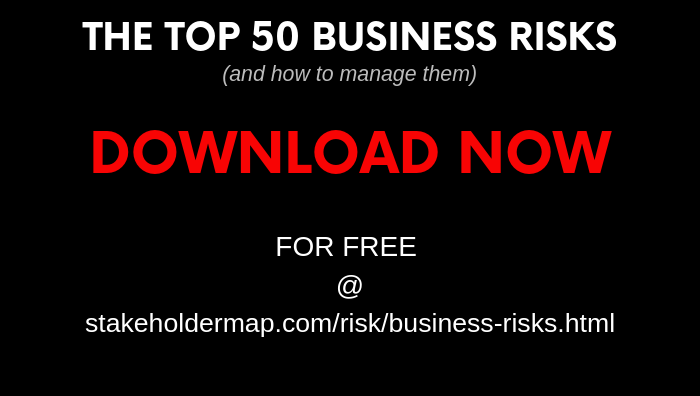
- Business Essentials
- Leadership & Management
- Credential of Leadership, Impact, and Management in Business (CLIMB)
- Entrepreneurship & Innovation
- Digital Transformation
- Finance & Accounting
- Business in Society
- For Organizations
- Support Portal
- Media Coverage
- Founding Donors
- Leadership Team

- Harvard Business School →
- HBS Online →
- Business Insights →
Business Insights
Harvard Business School Online's Business Insights Blog provides the career insights you need to achieve your goals and gain confidence in your business skills.
- Career Development
- Communication
- Decision-Making
- Earning Your MBA
- Negotiation
- News & Events
- Productivity
- Staff Spotlight
- Student Profiles
- Work-Life Balance
- AI Essentials for Business
- Alternative Investments
- Business Analytics
- Business Strategy
- Business and Climate Change
- Creating Brand Value
- Design Thinking and Innovation
- Digital Marketing Strategy
- Disruptive Strategy
- Economics for Managers
- Entrepreneurship Essentials
- Financial Accounting
- Global Business
- Launching Tech Ventures
- Leadership Principles
- Leadership, Ethics, and Corporate Accountability
- Leading Change and Organizational Renewal
- Leading with Finance
- Management Essentials
- Negotiation Mastery
- Organizational Leadership
- Power and Influence for Positive Impact
- Strategy Execution
- Sustainable Business Strategy
- Sustainable Investing
- Winning with Digital Platforms
What Is Risk Management & Why Is It Important?

- 24 Oct 2023
Businesses can’t operate without risk. Economic, technological, environmental, and competitive factors introduce obstacles that companies must not only manage but overcome.
According to PwC’s Global Risk Survey , organizations that embrace strategic risk management are five times more likely to deliver stakeholder confidence and better business outcomes and two times more likely to expect faster revenue growth.
If you want to enhance your job performance and identify and mitigate risk more effectively, here’s a breakdown of what risk management is and why it’s important.
Access your free e-book today.
What Is Risk Management?
Risk management is the systematic process of identifying, assessing, and mitigating threats or uncertainties that can affect your organization. It involves analyzing risks’ likelihood and impact, developing strategies to minimize harm, and monitoring measures’ effectiveness.
“Competing successfully in any industry involves some level of risk,” says Harvard Business School Professor Robert Simons, who teaches the online course Strategy Execution . “But high-performing businesses with high-pressure cultures are especially vulnerable. As a manager, you need to know how and why these risks arise and how to avoid them.”
According to Strategy Execution , strategic risk has three main causes:
- Pressures due to growth: This is often caused by an accelerated rate of expansion that makes staffing or industry knowledge gaps more harmful to your business.
- Pressures due to culture: While entrepreneurial risk-taking can come with rewards, executive resistance and internal competition can cause problems.
- Pressures due to information management: Since information is key to effective leadership , gaps in performance measures can result in decentralized decision-making.
These pressures can lead to several types of risk that you must manage or mitigate to avoid reputational, financial, or strategic failures. However, risks aren’t always obvious.
“I think one of the challenges firms face is the ability to properly identify their risks,” says HBS Professor Eugene Soltes in Strategy Execution .
Therefore, it’s crucial to pinpoint unexpected events or conditions that could significantly impede your organization’s business strategy .
Related: Business Strategy vs. Strategy Execution: Which Course Is Right for Me?
According to Strategy Execution , strategic risk comprises:
- Operations risk: This occurs when internal operational errors interrupt your products or services’ flow. For example, shipping tainted products can negatively affect food distribution companies.
- Asset impairment risk: When your company’s assets lose a significant portion of their current value because of a decreased likelihood of receiving future cash flows . For instance, losing property assets, like a manufacturing plant, due to a natural disaster.
- Competitive risk: Changes in the competitive environment can interrupt your organization’s ability to create value and differentiate its offerings—eventually leading to a significant loss in revenue.
- Franchise risk: When your organization’s value erodes because stakeholders lose confidence in its objectives. This primarily results from failing to control any of the strategic risk sources listed above.
Understanding these risks is essential to ensuring your organization’s long-term success. Here’s a deeper dive into why risk management is important.
4 Reasons Why Risk Management Is Important
1. protects organization’s reputation.
In many cases, effective risk management proactively protects your organization from incidents that can affect its reputation.
“Franchise risk is a concern for all businesses,“ Simons says in Strategy Execution . “However, it's especially pressing for businesses whose reputations depend on the trust of key constituents.”
For example, airlines are particularly susceptible to franchise risk because of unforeseen events, such as flight delays and cancellations caused by weather or mechanical failure. While such incidents are considered operational risks, they can be incredibly damaging.
In 2016, Delta Airlines experienced a national computer outage, resulting in over 2,000 flight cancellations. Delta not only lost an estimated $150 million but took a hit to its reputation as a reliable airline that prided itself on “canceling cancellations.”
While Delta bounced back, the incident illustrates how mitigating operational errors can make or break your organization.
2. Minimizes Losses
Most businesses create risk management teams to avoid major financial losses. Yet, various risks can still impact their bottom lines.
A Vault Platform study found that dealing with workplace misconduct cost U.S. businesses over $20 billion in 2021. In addition, Soltes says in Strategy Execution that corporate fines for misconduct have risen 40-fold in the U.S. over the last 20 years.
One way to mitigate financial losses related to employee misconduct is by implementing internal controls. According to Strategy Execution , internal controls are the policies and procedures designed to ensure reliable accounting information and safeguard company assets.
“Managers use internal controls to limit the opportunities employees have to expose the business to risk,” Simons says in the course.
One company that could have benefited from implementing internal controls is Volkswagen (VW). In 2015, VW whistle-blowers revealed that the company’s engineers deliberately manipulated diesel vehicles’ emissions data to make them appear more environmentally friendly.
This led to severe consequences, including regulatory penalties, expensive vehicle recalls, and legal settlements—all of which resulted in significant financial losses. By 2018, U.S. authorities had extracted $25 billion in fines, penalties, civil damages, and restitution from the company.
Had VW maintained more rigorous internal controls to ensure transparency, compliance, and proper oversight of its engineering practices, perhaps it could have detected—or even averted—the situation.
Related: What Are Business Ethics & Why Are They Important?
3. Encourages Innovation and Growth
Risk management isn’t just about avoiding negative outcomes. It can also be the catalyst that drives your organization’s innovation and growth.
“Risks may not be pleasant to think about, but they’re inevitable if you want to push your business to innovate and remain competitive,” Simons says in Strategy Execution .
According to PwC , 83 percent of companies’ business strategies focus on growth, despite risks and mixed economic signals. In Strategy Execution , Simons notes that competitive risk is a challenge you must constantly monitor and address.
“Any firm operating in a competitive market must focus its attention on changes in the external environment that could impair its ability to create value for its customers,” Simons says.
This requires incorporating boundary systems —explicit statements that define and communicate risks to avoid—to ensure internal controls don’t extinguish innovation.
“Boundary systems are essential levers in businesses to give people freedom,” Simons says. “In such circumstances, you don’t want to stifle innovation or entrepreneurial behavior by telling people how to do their jobs. And if you want to remain competitive, you’ll need to innovate and adapt.”

Netflix is an example of how risk management can inspire innovation. In the early 2000s, the company was primarily known for its DVD-by-mail rental service. With growing competition from video rental stores, Netflix went against the grain and introduced its streaming service. This changed the market, resulting in a booming industry nearly a decade later.
Netflix’s innovation didn’t stop there. Once the steaming services market became highly competitive, the company shifted once again to gain a competitive edge. It ventured into producing original content, which ultimately helped differentiate its platform and attract additional subscribers.
By offering more freedom within internal controls, you can encourage innovation and constant growth.
4. Enhances Decision-Making
Risk management also provides a structured framework for decision-making. This can be beneficial if your business is inclined toward risks that are difficult to manage.
By pulling data from existing control systems to develop hypothetical scenarios, you can discuss and debate strategies’ efficacy before executing them.
“Interactive control systems are the formal information systems managers use to personally involve themselves in the decision activities of subordinates,” Simons says in Strategy Execution . “Decision activities that relate to and impact strategic uncertainties.”
JPMorgan Chase, one of the most prominent financial institutions in the world, is particularly susceptible to cyber risks because it compiles vast amounts of sensitive customer data . According to PwC , cybersecurity is the number one business risk on managers’ minds, with 78 percent worried about more frequent or broader cyber attacks.
Using data science techniques like machine learning algorithms enables JPMorgan Chase’s leadership not only to detect and prevent cyber attacks but address and mitigate risk.

Start Managing Your Organization's Risk
Risk management is essential to business. While some risk is inevitable, your ability to identify and mitigate it can benefit your organization.
But you can’t plan for everything. According to the Harvard Business Review , some risks are so remote that no one could have imagined them. Some result from a perfect storm of incidents, while others materialize rapidly and on enormous scales.
By taking an online strategy course , you can build the knowledge and skills to identify strategic risks and ensure they don’t undermine your business. For example, through an interactive learning experience, Strategy Execution enables you to draw insights from real-world business examples and better understand how to approach risk management.
Do you want to mitigate your organization’s risks? Explore Strategy Execution —one of our online strategy courses —and download our free strategy e-book to gain the insights to build a successful strategy.

About the Author
Why Are Major Risks in the Business Plan?
Risk factors are possible events that, should they happen, could cause a company's revenues or profits to be lower than what the owner had forecast. They are a standard part of a thorough business plan, whether the plan is designed for internal use by the management team or will be presented to outside investors. Risk factors are also called threats, because they threaten the business's success and in extreme circumstances even its survival.
Encourages Contingency Planning
The risk factors section of the business plan should go beyond simply listing what might go wrong. Being aware of what could negatively impact the company is important, but the real value of including risk factors is the business owner's thinking process to determine how she would mitigate the risks to minimize the financial damage to her company. The thinking process is referred to as contingency planning, also know as "what if" analysis. The business owner will make changes to her marketing strategies, operations and financial management in response to these risks becoming a reality.
Advertisement
Article continues below this ad
More For You
Purpose of financial analysis, strategic analysis of a company, what is 'systems thinking' in business, the purpose of analytical business reports, fundamental principles of strategic & business planning models, focus on the business environment.
A company should have a system in place to gather information about emerging or potential risks. Monitoring competitors on an ongoing basis is one aspect of this system. The decisions a company's competitors make pose threats, because they are designed to give the competitors a stronger market position by taking potential business away from the company. Risk factors are not just considered at the time the company is preparing its annual business plan -- they are year-round considerations, because new threats emerge throughout the year.
Alert Potential Investors
A venture capital firm or angel investor that is contemplating putting money into a business enterprise must assess the risk that the company's financial results will be lower than forecast. The value of the company grows as the revenues and profits of the business grow. The risk factors alert the investor to the fact there is always a possibility of losing part or all of the money he puts into the company. If the investor believes the risks could severely hurt the company should they occur, he may decline to make the investment. As a practical matter, sophisticated investors do their own risk analysis prior to putting money in a company, but the fact the management team is aware of, and has strategies for dealing with, the risks can make the investors more confident about the management team's abilities.
Moving Forward Confidently
Analyzing risk factors allows the management team to be confident it is ready for whatever business environment the company may face in the upcoming year and beyond. The team has strategies in place that can be quickly implemented to minimize the damage caused by threats from competitors or changes in the overall economy. The management team assesses which risks are most likely to become actual threats and which have a very low likelihood of occurring. Owners of companies will always have external threats to worry about, but the risk analysis process helps reduce the number of worries to those that have the potential to negatively impact their revenues or profits.
- Inc.: Managing Risk in a New Venture
Brian Hill is the author of four popular business and finance books: "The Making of a Bestseller," "Inside Secrets to Venture Capital," "Attracting Capital from Angels" and his latest book, published in 2013, "The Pocket Small Business Owner's Guide to Business Plans."
- Sign up for free
- SafetyCulture
- Risk Analysis
Risk Analysis: A Comprehensive Guide
Everything you need to know about risk analysis: its components, types, and methods, as well as examples and steps on how to perform risk analysis

What is Risk Analysis?
Risk analysis is a multi-step process aimed at mitigating the impact of risks on business operations. Leaders from different industries use risk analysis to ensure that all aspects of the business are protected from potential threats. Performing regular risk analysis also minimizes the vulnerability of the business to unexpected events.
Difference Between Risk Assessment and Risk Analysis
Risk assessment is just one component of risk analysis. The other components of risk analysis are risk management and risk communication. Risk management is the proactive control and evaluation of risks while risk communication is the exchange of information involving risks. Unlike risk analysis, risk assessment is primarily focused on safety and hazard identification .
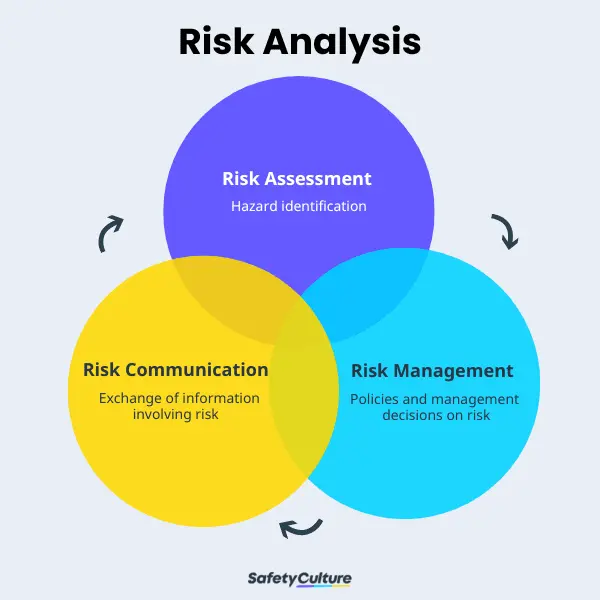
Risk Analysis Framework
Types of Risk Analysis
As risk analysis covers a wide range of topics, there are many approaches to analyzing risks or types of risk analysis. These include, but are not limited to, the following:
- Risk Benefit & Cost Benefit Analysis A risk benefit analysis involves weighing the pros and cons (benefits and risks) of an action. Elements are ranked and evaluated against the impact of their potential success or failure. Meanwhile, a cost benefit analysis sums the projected or estimated costs of an action and weighs the total cost against the potential benefits and opportunities.Both types of analysis help leaders carefully weigh their decision in pursuing a plan or action. Choosing to pursue a risk-heavy or cost-heavy action can result in losses.
- Needs Assessment A needs assessment is a systematic process of identifying and evaluating organizational needs and gaps. It gives leaders an idea of where the business may be lacking and helps them refocus resources towards achieving goals more efficiently.
- Business Impact Analysis A business impact analysis entails planning for operational disruptions caused by natural disasters and other external factors. It is the basis for investment in recovery, prevention, and mitigation strategies.
- Failure Mode and Effect Analysis A failure mode and effects analysis is a systematic method of anticipating potential failures in business processes and mitigating their impact on customers. It improves product and service reliability and reduces the cost of failures.
- Root Cause Analysis A root cause analysis focuses on identifying and eliminating root causes to solve problems. It helps in the prevention of recurring problems by targeting the ineffective systems behind them. Aside from failure mode and effects analysis, other root cause analysis tools are 5 Whys , 8D , and DMAIC (part of Six Sigma ).
Risk Analysis Methods
There are two main risk analysis methods. The easier and more convenient method is qualitative risk analysis. Qualitative risk analysis rates or scores risk based on the perception of the severity and likelihood of its consequences. Quantitative risk analysis , on the other hand, calculates risk based on available data.
Types of risk analysis associated with qualitative risk analysis are all root cause analysis (RCA) tools except for failure mode and effects analysis, needs assessment, and risk matrix. Furthermore, the most common types of the latter are the 3×3 risk matrix, 4×4 risk matrix, and 5×5 risk matrix .
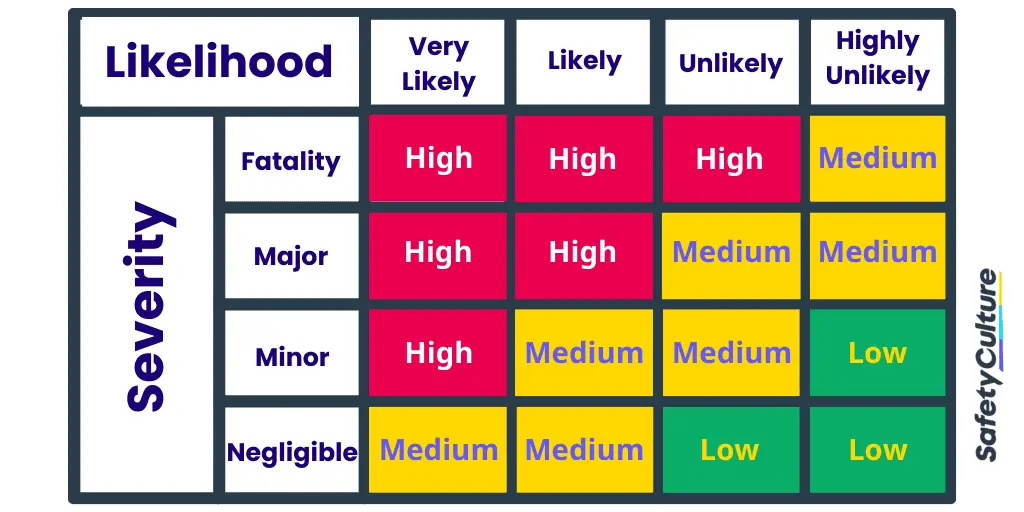
Risk Assessment Matrix | SafetyCulture
Types of risk analysis included in quantitative risk analysis are business impact analysis (BIA), failure mode and effects analysis (FMEA), and risk benefit analysis.
A key difference between qualitative and quantitative risk analysis is the type of risk each method results in. For qualitative risk analysis, this is projected risk, which is an estimation or guess of how the risk will manifest. Meanwhile, quantitative risk analysis deals with statistical risk. Unlike projected risk, statistical risk is specific and verified. For this reason, it’s often used in the calculation of insurance premiums.
Risk Analysis Example
Though risk analysis is used across industries by businesses of all sizes and types, some leaders may find a risk analysis example that’s specific to their industry more helpful than a generic one. Here are risk analysis examples for three major industries: construction, transport & logistics, and manufacturing.
Construction Risk Analysis Example : The owner of a construction company was presented with a project proposal to build a luxury resort. While pursuing this project may lead to good press for the company, the owner is hesitant to accept the project because her company specializes in mid-range residential buildings. Taking on this project would be both a leap and a challenge. Before making a final decision, she performs a risk-benefit analysis together with her team to see if the benefits of pursuing this project outweigh the risks.
Transport & Logistics Risk Analysis Example : The director of a multinational shipping company is anxious about the impact an upcoming storm will have on business operations. She believes the company should set aside some money for recovery after the storm hits. Her colleague, however, thinks differently. He argues that the storm won’t affect them that much. To convince her colleague and fellow directors, she performs a business impact analysis and presents its results in the next board meeting.
Manufacturing Risk Analysis Example : A newly hired manager is in charge of preparing a factory and its workers for a large influx of customer orders due to the summer season. To get an understanding of what he needs to do for this factory to succeed in producing enough units, he performs a quick needs assessment by asking the workers to fill out a survey on the factory’s processes.
How to Perform Risk Analysis
For leaders who have already decided on the type of risk analysis to perform, here are steps and instructions on how to perform risk analysis for each type:
How to Perform Needs Assessment
- Step 1: Identify requirements – What must the business deliver to succeed?
- Step 2: Assess existing resources – What can be used to achieve success?
- Step 3: Identify needs – What does the business lack that is critical to success?
- Step 4: Develop a plan of action – What must be done to fill the gaps and succeed?
Needs Assessment Template
Use this digital template to identify business/department, performance, and learning needs. It has all the tools leaders need to improve the management of their businesses.
How to Perform Business Impact Analysis
- Step 1: Gather information on business processes, finances, and management.
- Step 2: Identify Recovery Time Objective (RTO) or how long it takes to restore business processes after disruption. RTO helps determine how long the business can function without normal business processes.
- Step 3: Identify Recovery Point Objective (RPO) or the acceptable loss to customers when a disruption occurs. RPO helps determine the estimated financial impact on the business.
- Step 4: Develop workaround procedures of the business in the event of disruption.
- Step 5: Decide business needs based on the information gathered in previous steps.
Business Impact Analysis Template
Use this digital template to assess the impact of possible disruptive events across key business functions. This template includes an assessment of losses in terms of operational activities and revenue. Leaders can use it to prioritize functions for recovery during crises.
How to Perform Failure Mode and Effects Analysis
- Step 1: Identify mechanism of failure
The mechanism of failure (potential failure modes, effects, and causes) can be identified properly when leaders in charge of FMEAs account for past failures, agree upon certain assumptions, and establish ground rules.
- Step 2: Determine RPN
The risk priority number is used to prioritize the potential failures that require additional planning. It’s a product of three factors: severity, occurrence, and detection.

FMEA: RPN Risk Analysis | SafetyCulture
Leaders should focus their improvement efforts on potential failures at the top 20% of the highest RPNs. These high-risk failure modes must be addressed through effective action plans.
- Step 3: Follow-up on actions
After establishing and executing effective action plans, leaders should remember to continuously review these plans and the high-risk failure modes they address.
Failure Mode and Effects Analysis Template
Use this digital template to identify problems in processes or products. Describe the potential failure effect, the potential cause, and current controls. Add the severity, occurrence, and detection ratings. Finally, record the RPN and sign-off.
How to Perform Root Cause Analysis
- Step 1: Define the problem – In the context of risk analysis, a problem is an observable consequence of an unidentified risk or root cause.
- Step 2: Select a tool – 5 Whys , 8D , or DMAIC
5 Whys involves asking the question “why” five times. Though 5 Whys is the easiest to use, it can also oversimplify problems. 8D stands for the eight disciplines of problem-solving. While 8D provides long-term solutions, performing it correctly requires extensive training .
DMAIC, on the other hand, is more comprehensive than 5 Whys, but also relatively easier to perform than 8D, especially if the third step (Analyze) is simplified.
- Step 3: Implement actions – Address root cause/s identified using the tool selected in the previous step by creating and implementing actions. These actions should be specific and directed to the person/s most capable of executing them.
Root Cause Analysis Template
Use this digital template to analyze a recurring problem and its effect on productivity. List reasons why the problem occurs and rate how likely they are to be root causes. Once a root cause has been identified, choose its category and provide a prevention strategy.
For leaders who haven’t decided on a specific type or want a general outline of how to perform risk analysis, refer to the steps below:
- Set the goal for risk analysis
- Collect data to identify risks
- Add values to risks
- Identify highest-priority risks
- Develop a plan to mitigate these risks
- Follow through with the plan
- Review the effectiveness of the plan
Create a Risk Analysis Template
Eliminate manual tasks and streamline your operations.
How to Manage and Communicate Risks
One way to manage risks effectively is to use the ISO 31000 standard. ISO 31000 is an internationally recognized benchmark for risk management. It can be summarized into three guiding rules for leaders to follow:
- Risk management must be structured, innovative, inclusive, dynamic, continuously improving, and customized to fit business objectives.
- Leaders must proactively integrate risk management on all levels of the business.
- Risk management policies and practices should support open risk communication.
Another key aspect of using ISO 31000 is to ensure that all employees are familiar with the standard and/or have received related training on how to apply the standard in their work. While leaders should take responsibility for the overall risk management, they should be careful to not alienate employees from this process. Without the support and input of employees, implementing ISO 31000 will be much harder than it needs to be.
Improve your GRC management
Simplify risk management and compliance with our centralized platform, designed to integrate and automate processes for optimal governance.
ISO 31000:2018 Risk Management Template
Use this digital template to establish a solid risk management framework based on ISO 31000. Show leadership by making a commitment to risk management. Share the responsibility of managing risks with other stakeholders in the business, including employees.
Though adhering to the ISO 31000 standard is recommended, this can seem intimidating or overly complicated for smaller businesses or those with less resources to spend on risk management. A temporary alternative is to use a risk management plan , which should have the following parts:
- Descriptions of all identified risks, their consequences, and possible causes
- A model for estimating the likelihood and severity of consequences (risk analysis)
- Corrective actions to target possible causes or to lessen the severity of consequences
When using a risk management plan , it can be helpful to have a risk management plan template that’s easy to distribute to employees and update when needed. Without a template, it can be difficult to use or create a risk management plan for the entire business.
Risk Management Plan Template
Use this digital template to assess the likelihood and severity of consequences. Specify planned mitigation strategies and the employee/s responsible for executing them. Give the estimated cost and timeline of mitigation actions.
Manage Risks with SafetyCulture (formerly iAuditor)
SafetyCulture is a digital inspection platform businesses can use to identify, analyze, communicate, and manage risks effectively. Together with Mitti, a technology-first insurance company, SafetyCulture rewards businesses that are proactive in managing their risks.
SafetyCulture Platform for Teams
Why use safetyculture.
Minimize your business’ vulnerability to unexpected events and potential threats with a digital tool like SafetyCulture .
✓ Simplify processes with digital checklists ✓ Receive professional reports and share instantly ✓ Use for teams of any size
Streamline your organization’s operations and workflow with our digital checklist. It empowers you to:
- Maintain safety and compliance standards with customizable templates
- Increase your team’s engagement and accountability including contractors and stakeholders
- Create powerful workflows by integrating your existing software
- Gain greater visibility and transparency with real-time reporting
- Access unlimited storage and data security for your reports
Take advantage of our comprehensive features to optimize your operations and enhance workplace safety today.
FAQs about Risk Analysis
What are the 4 components of risk analysis.
The four components of risk analysis are hazard identification, risk assessment, risk management, and risk communication. The risk analysis process follows a general format but can differ based on the needs of an organization or which structure works for them.
What is a risk analysis checklist?
A risk analysis checklist or template is a document that you can use to verify that all aspects of a project or business are analyzed for potential risks. Utilizing this kind of tool helps ensure that nothing was overlooked and also helps maintain a standardized approach when it comes to managing risks.
What is the most commonly used technique for risk analysis?
The most commonly used technique for risk analysis is through the use risk matrix. It is a simple yet effective method that helps assess and prioritize risks based on their likelihood of occurrence and potential impact on a project or business. The risk matrix is typically represented with a visual aid or chart.
SafetyCulture Content Team
Related articles

- Hazard Elimination
Explore the importance of hazard elimination across industries and understand the strategies that solve critical safety issues for employee protection, long-term operational benefits, and sustainable financial success.
- Find out more

- Layer of Protection Analysis
Discover the key aspects of and strategies for LOPA to effectively evaluate and enhance safety systems in high-risk industries.

- Dust Hazard Analysis
Explore the essential components of DHA, its significance, and the strategies for ensuring industrial safety.
Related pages
- Hazard Assessment Software
- Process Hazard Analysis Software
- EHS Risk Assessment Software
- Integrated Risk Management Software
- Operational Risk Management Software
- Reputational Risk
- Reputation Management
- Safety Improvement Plan Template
- Contract Risk Assessment Checklist
- Point of Work Risk Assessment Template
- 7 Best Risk Assessment Templates
- 5×5 Risk Matrix Template
Value and resilience through better risk management
Today’s corporate leaders navigate a complex environment that is changing at an ever-accelerating pace. Digital technology underlies much of the change. Business models are being transformed by new waves of automation, based on robotics and artificial intelligence. Producers and consumers are making faster decisions, with preferences shifting under the influence of social media and trending news. New types of digital companies are exploiting the changes, disrupting traditional market leaders and business models. And as companies digitize more parts of their organization, the danger of cyberattacks and breaches of all kinds grows.
Stay current on your favorite topics
Beyond cyberspace, the risk environment is equally challenging. Regulation enjoys broad popular support in many sectors and regions; where it is tightening, it is putting stresses on profitability. Climate change is affecting operations and consumers and regulators are also making demands for better business conduct in relation to the natural environment. Geopolitical uncertainties alter business conditions and challenge the footprints of multinationals. Corporate reputations are vulnerable to single events, as risks once thought to have a limited probability of occurrence are actually materializing.
The role of the board and senior executives
Risk management at nonfinancial companies has not kept pace with this evolution. For many nonfinancial corporates, risk management remains an underdeveloped and siloed capability in the organization, receiving limited attention from the most senior leaders. From over 1,100 respondents to McKinsey’s Global Board Survey for 2017 , we discovered that risk management remains a relatively low-priority topic at board meetings (exhibit).
A long way to go
Boards spend only 9 percent of their time on risk—slightly less than they did in 2015. Other questions in the survey revealed that only 6 percent of respondents believe that they are effective in managing risk (again, less than in 2015). Some individual risk areas are relatively neglected, and even cybersecurity, a core risk area with increasing importance, is addressed by only 36 percent of boards. While many senior executives stay focused on strategy and performance management, they often fail to challenge capabilities or strategic decisions from a risk perspective (see sidebar, “A long way to go”). A reactive approach to risks remains too common, with action taken only after things go wrong. The result is that boards and senior executives needlessly put their companies at risk, while personally taking on higher legal and reputational liabilities.
Boards have a critical role to play in developing risk-management capabilities at the companies they oversee. First, boards need to ensure that a robust risk-management operating model is in place. Such a model allows companies to understand and prioritize risks, set their risk appetite, and measure their performance against these risks. The model should enable the board and senior executives to work with businesses to eliminate exposures outside the company’s appetite statement, reducing the risk profile where warranted, through such means as quality controls and other operational processes. On strategic opportunities and risk trade-offs, boards should foster explicit discussions and decision making among top management and the businesses. This will enable the efficient deployment of scarce risk resources and the active, coordinated management of risks across the organization. Companies will then be prepared to address and manage emerging crises when risks do materialize.
A sectoral view of risks
Most companies operate in a complex, industry-specific risk environment. They must navigate macroeconomic and geopolitical uncertainties and face risks arising in the areas of strategy, finance, products, operations, and compliance and conduct. In some sectors, companies have developed advanced approaches to managing risks that are specific to their business models. These approaches can sustain significant value. At the same time companies are challenged by emerging types of risks for which they need to develop effective mitigation plans; in their absence, the losses from serious risk events can be crippling.
- Automotive companies are controlling supply-chain risks with sophisticated monitoring models that allow OEMs to identify potential risks upfront across the supply chain. At the same time, auto companies must address the strategic challenge of shifting toward electric-powered and autonomous vehicles.
- Pharma companies seek to manage the downside risk of large investments in their product portfolio and pipeline, while addressing product quality and patient safety to comply with relevant regulatory requirements.
- Oil and gas, steel, and energy companies apply advanced approaches to manage the negative effects of financial markets and commodity-price volatility. As social and political demands for cleaner energy are increasing, these companies are actively pursuing growth opportunities to shift their portfolios in anticipation of an energy transition and a low-carbon future.
- Consumer-goods companies protect their reputation and brand value through sound practices to manage product quality as well as labor conditions in their production facilities. Yet they are constantly challenged to meet consumers’ ever-changing tastes and needs, as well as consumer-protection regulations.
Toward proactive risk management
An approach based on adherence to minimum regulatory standards and avoidance of financial loss creates risk in itself. In a passive stance, companies cannot shape an optimal risk profile according to their business models nor adequately manage a fast-moving crisis. Eschewing a risk approach comprised of short-term performance initiatives focused on revenue and costs, top performers deem risk management as a strategic asset, which can sustain significant value over the long term. Inherent in the proactive approach are several essential components.
Strategic decision making
More rigorous, debiased strategic decision making can enhance the longer-term resilience of a company’s business model, particularly in volatile markets or externally challenged industries. Research shows that the active, regular reevaluation of resource allocation, based on sound assessments of risk and return trade-offs (such as entering markets where the business model is superior to the competition), creates more value and better shareholder returns. 1 See, for example, Yuval Atsmon, “ How nimble resource allocation can double your company’s value ,” August 2016; William N. Thorndike, Jr., The Outsiders: Eight Unconventional CEOs and Their Radically Rational Blueprint for Success , Boston, MA: Harvard Business Review Press, 2012; Rebecca Darr and Tim Koller, “ How to build an alliance against corporate short-termism ,” January 2017. Flexibility is empowering in a dynamic marketplace. Many companies use hedging strategies to insure against market uncertainties. Airlines, for example, have been known to hedge future exposures to fuel-price fluctuations, a move that can help maintain profitability when prices climb. Likewise, strategic investing, based on a longer-term perspective and a deep understanding of a company’s core proposition, generates more value than opportunistic moves aiming at a short-term bump in the share price.
Debiasing and stress-testing
Approaches that include debiasing and stress-testing help senior executives consider previously overlooked sources of uncertainty to judge whether the company’s risk-bearing capacity can absorb their potential impact. A utility in Germany, for example, improved decision making by taking action to mitigate behavioral biases. As a result, it separated its renewables business from its conventional power-generation operations. In the aftermath of the Fukushima disaster, which sharply raised interest in environmentally friendly power generation, the utility’s move led to a significant positive effect on its share price (15 percent above the industry index).
Higher-quality products and safety standards
Investments in product quality and safety standards can bring significant returns. One form this takes in the energy sector is reduced damage and maintenance costs. At one international energy company, improved safety standards led to a 30 percent reduction in the frequency of hazardous incidents. Auto companies with reputations built on safety can command higher prices for their vehicles, while the better reputation created by higher quality standards in pharma creates obvious advantages. As well as the boost in demand that comes from a reputation for quality, companies can significantly reduce their remediation costs—McKinsey research suggests that pharma companies suffering from quality issues lose annual revenue equal to 4 to 5 percent of cost of goods sold.
Comprehensive operative controls
These can lead to more efficient and effective processes that are less prone to disruption when risks materialize. In the auto sector, companies can ensure stable production and sales by mitigating the risk of supply-chain disruption. Following the 2011 earthquake and tsunami, a leading automaker probed potential supply bottlenecks and took appropriate action. After an earthquake in 2016, the company quickly redirected production of affected parts to other locations, avoiding costly disruptions. In high-tech, companies applying superior supply-chain risk management can achieve lasting cost savings and higher margins. One global computer company addressed these risks with a dedicated program that saved $500 million during its first six years. The program used risk-informed contracts, enabling suppliers to lower the costs and risks of doing business with the company. The measures achieved supply assurance for key components, particularly during market shortages, improved cost predictability for components that have volatile costs, and optimized inventory levels internally and at suppliers.
Stronger ethical and societal standards
To achieve standing among customers, employees, business partners, and the public, companies can apply ethical controls on corporate practices end to end. If appropriately publicized and linked to corporate social responsibility, a program of better ethical standards can achieve significant returns in the form of heightened reputation and brand recognition. Customers, for example, are increasingly willing to pay a premium for products of companies that adhere to tighter standards. Employees too appreciate being associated with more ethical companies, offering a better working environment and contributing to society.
The three dimensions of effective risk management
Ideally, risk management and compliance are addressed as strategic priorities by corporate leadership and day-to-day management. More often the reality is that these areas are delegated to a few people at the corporate center working in isolation from the rest of the business. By contrast, revenue growth or cost savings are deeply embedded in corporate culture, linked explicitly to profit-and-loss (P&L) performance at the company level. Somewhere in the middle are specific control capabilities regarding, for example, product safety, secure IT development and deployment, or financial auditing.
Would you like to learn more about our Risk Practice ?
To change this picture, leadership must commit to building robust, effective risk management. The project is three-dimensional: 1) the risk operating model, consisting of the main risk management processes; 2) a governance and accountability structure around these processes, leading from the business up to the board level; and 3) best-practice crisis preparedness, including a well-articulated response playbook if the worst case materializes.
1. Developing an effective risk operating model
The operating model consists of two layers, an enterprise risk management (ERM) framework and individual frameworks for each type of risk. The ERM framework is used to identify risks across the organization, define the overall risk appetite, and implement the appropriate controls to ensure that the risk appetite is respected. Finally, the overarching framework puts in place a system of timely reporting and corresponding actions on risk to the board and senior management. The risk-specific frameworks address all risks that are being managed. These can be grouped in categories, such as financial, nonfinancial, and strategic. Financial risks, such as liquidity, market, and credit risks, are managed by adhering to appropriate limit structures; nonfinancial risks, by implementing adequate process controls; strategic risks, by challenging key decisions with formalized approaches such as debiasing, scenario analyses, and stress testing. While financial and strategic risks are typically managed according to the risk-return trade-off, for nonfinancial risks, the potential downside is often the key consideration.
Finding the right level of risk appetite
Companies need to find the right level of risk appetite, which helps ensure long-term resilience and performance. Risk appetite that is too relaxed or too restrictive can have severe consequences on company financials, as the following two examples indicate:
Too relaxed. One nuclear energy company set its standards for steel equipment in the 1980s and did not review them even when the regulations changed. When the new higher standards were applied to the manufacture of equipment for nuclear power plants, the company fell short of compliance. An earlier adaptation of its risk appetite and tolerance levels would have been significantly less costly.
Too restrictive. A pharma company set quality tolerances to produce a drug to a significantly stricter level than what was required by regulation. At the beginning of production, tolerance intervals could be fulfilled, but over time, quality could no longer be assured at the initial level. The company was unable to lower standards, as these had been communicated to the regulators. Ultimately, production processes had to be upgraded at a significant cost to maintain the original tolerances.
As well as assessing risk based on likelihood and impact, companies must also assess their ability to respond to emerging risks. Capabilities and capacities needed to manage these risks should be evaluated and gaps filled accordingly. Of particular importance in crisis management is the timeliness of an effective response when things go awry. The highly likely, high-impact risk events on which risk management focuses most of its attention often emerge with disarming velocity, taking many companies unawares. To be effective, the enterprise risk management framework must ensure that the two layers are seamlessly integrated. It does this by providing clarity on risk definitions and appetite as well as controls and reporting.
- Taxonomy. A company-wide risk taxonomy should clearly and comprehensively define risks; the taxonomy should be strictly respected in the definition of risk appetite, in the development of risk policy and strategy, and in risk reporting. Taxonomies are usually industry-specific, covering strategic, regulatory, and product risks relevant to the industry. They are also determined by company characteristics, including the business model and geographical footprint (to incorporate specific country and legal risks). Proven risk-assessment tools need to be adopted and enhanced continuously with new techniques, so that newer risks (such as cyberrisk) are addressed as well as more familiar risks.
- Risk appetite. A clear definition of risk appetite will translate risk-return trade-offs into explicit thresholds and limits for financial and strategic risks, such as economic capital, cash-flow at risk, or stressed metrics. In the case of nonfinancial risks like operational and compliance risks, the risk appetite will be based on overall loss limits, categorized into inherent and residual risks (see sidebar, “Finding the right level of risk appetite”).
- Risk control processes. Effective risk control processes ensure that risk thresholds for the specified risk appetite are upheld at all levels of the organization. Leading companies are increasingly building their control processes around big data and advanced analytics. These powerful new capabilities can greatly increase the effectiveness and efficiency of risk monitoring processes. Machine-learning tools, for example, can be very effective in monitoring fraud and prioritizing investigations; automated natural language processing within complaints management can be used to monitor conduct risk.
- Risk reporting. Decision making should be informed with risk reporting. Companies can regularly provide boards and senior executives with insights on risk, identifying the most relevant strategic risks. The objective is to ensure that an independent risk view, encompassing all levels of the organization, is embedded into the planning process. In this way, the risk profile can be upheld in the management of business initiatives and decisions affecting the quality of processes and products. Techniques like debiasing and the use of scenarios can help overcome biases toward fulfilment of short-term goals. A North American oil producer developed a strategic hypothesis given uncertainties in global and regional oil markets. The company used risk modelling to test assumptions about cash flow under different scenarios and embedded these analyses into the reports reviewed by senior management and the board. Weak points in the strategy were thereby identified and mitigating actions taken.
2. Toward robust risk governance, organization, and culture
The risk operating model must be managed through an effective governance structure and organization with clear accountabilities. The governance model maintains a risk culture that strongly reinforces better risk and compliance management across the three lines of defense—business and operations, the compliance and risk functions, and audit. The approach recognizes the inherent contradiction in the first line between performance (revenue and costs) and risk (losses). The role of the second line is to review and challenge the first line on the effectiveness of its risk processes and controls, while the third line, audit, ensures that the lines one and two are functioning as intended.
- Three lines of defense. Effective implementation of the three lines involves the sharp definition of lines one and two at all levels, from the group level through the lines of business, to the regional and legal entity levels. Accountabilities regarding risk and control management must be clear. Risk governance may differ by risk type: financial risks are usually managed centrally, while operational risks are deeply embedded into company processes. The operational risk of any line of business is managed by the business owning the product-development, production, and sales processes. This usually translates into forms of quality control, but the business must also balance the broader impact of risk and P&L. In the development of new diesel engines, automakers lost sight of the balance between compliance risk and the additional cost to meet emission standards, with disastrous results. Risk or compliance functions can only complement these activities by independently reviewing the adequacy of operational risk management, such as through technical standards and controls.
- Reviewing the risk appetite and risk profile. Of central importance within the governance structure are the committees that define the risk appetite, including the parameters for doing business. These committees also make specific decisions on top risks and review the control environment for enhancements as the company’s risk profile changes. Good governance in this case means that risk decisions are considered within the existing divisional, regional, and senior-management governance structure of a company, supported by risk, compliance, and audit committees.
- Integrated risk and compliance governance setup. A robust and adequately staffed risk and compliance organization supports all risk processes. The integrated risk and compliance organization provides for single ownership of the group-wide ERM framework and standards, appropriate clustering of second-line functions, a clear matrix between divisions and control functions, and centralized or local control as needed. A clear trend is observable whereby the ERM layer responsible for group-wide standards, risk processes, and reporting becomes consolidated, whereas the expert teams setting and monitoring specific control standards for the business (including standards for commercial, technical compliance, IT or cyberrisks) become specialized teams covering both regulatory compliance as well as risk aspects.
- Resources. Appropriate resources are a critical factor in successful risk governance. The size of the compliance, risk, audit, and legal functions of nonfinancial companies (0.5 for every 100 employees, on average), are usually much smaller than those of banks (6.9 for every 100 employees). The disparity is partly a natural outcome of financial regulation, but some part of it reflects a capability gap in nonfinancial corporates. These companies usually devote most of their risk and control resources in sector-specific areas, such as health and safety for airlines and nuclear power companies or quality assurance for pharmaceutical companies. The same companies can, however, neglect to provide sufficient resources to monitor highly significant risks, such as cyberrisk or large investments.
- Risk culture. An enhanced risk culture covers mind-sets and behaviors across the organization. A shared understanding is fostered of key risks and risk management, with leaders acting as role models. Especially important are capability-building programs on risk as well as formal mechanisms to assess and reinforce sound risk management practices.
An enhanced risk culture covers mind-sets and behaviors across the organization. A shared understanding is fostered of key risks and risk management, with leaders acting as role models.
3. Crisis preparedness and response
A high-performing, effective risk operating model and governance structure, with a well-developed risk culture minimize the probability of corporate crises , without, of course, completely eliminating them. When unexpected crises strike at high velocity, multinational companies can lose billions in value in the first days and soon find themselves struggling to keep their market position. A best-in-class risk management environment provides the ideal conditions for preparation and response.
- Ensure board leadership. The most important action companies can take to prepare for crises is to ensure that the effort is led by the board and senior management. Top leadership must define the main expected threats, the worst-case scenarios, and the actions and communications that will be accordingly rolled out. For each threat, hypothetical scenarios should be developed for how a crisis will unfold, based on previous crises within and beyond the company’s industry and region.
- Strengthen resilience. By mapping patterns that arose in previous crises, companies can test their own resilience, challenging key areas across the organization for potential weaknesses. Targeted countermeasures can then be developed in advance to strengthen resilience. This crucial aspect of crisis preparedness can involve reviewing and revising the terms and conditions for key suppliers, shoring up financials to ensure short-term availability of cash, or investing in advanced cybersecurity measures to protect essential data and software in the event of failures and breaches.
- Develop action plans and communications. Once these assessments are complete and resilience-building countermeasures are in place, the company can then develop action plans for each threat. The plans must be well articulated, founded on past crises, and address operational and technical planning, financial planning, third-party management, and legal planning. Care should be taken to develop an optimally responsive communications strategy as well. The correct strategy will enable frontline responders to keep pace with or stay ahead of unfolding crises. Communications failures can turn manageable crises into irredeemable catastrophes. Companies need to have appropriate scripts and process logic in place detailing the response to crisis situations, communicated to all levels of the organization and well anchored there. Airlines provide an example of the well-articulated response, in their preparedness for an accident or crash. Not only are detailed scripts in place, but regular simulations are held to train employees at all levels of the company.
- Train managers at all levels. The company should train key managers at multiple levels on what to expect and enable them to feel the pressures and emotions in a simulated environment. Doing this repeatedly and in a richer way each time will significantly improve the company’s response capabilities in a real crisis situation, even though the crisis may not be precisely the one for which managers have been trained. They will also be valuable learning exercises in their own right.
- Put in place a detailed crisis-response playbook. While each crisis can unfold in unique and unpredictable ways, companies can follow a few fundamental principles of crisis response in all situations. First, establish control immediately after the crisis hits, by closely determining the level of exposure to the threat and identifying a crisis-response leader, not necessarily the CEO, who will direct appropriate actions accordingly. Second, involved parties—such as customers, employees, shareholders, suppliers, government agencies, the media, and the wider public—must be effectively engaged with a dynamic communications strategy. Third, an operational and technical “war room” should be set up, to stabilize primary threats and determine which activities to sustain and which to suspend (identifying and reaching out to critical suppliers). Finally, a deliberate effort must be made to address and neutralize the root cause of the crisis and so bring it to an end as soon as possible.
In a digitized, networked world, with globalized supply chains and complex financial interdependencies, the risk environment has grown more perilous and costly. A holistic approach to risk management, based on the lessons, good and bad, of leading companies and financial institutions, can derive value from that environment. The path to risk resilience that is emerging is an effort, led by the board and senior management, to establish the right risk profile and appetite. Success depends on the support of a thriving risk culture and state-of-the-art crisis preparedness and response. Far from minimal regulatory adherence and loss avoidance, the optimal approach to risk management consists of fundamentally strategic capabilities, deeply embedded across the organization.
Daniela Gius is a senior expert in McKinsey’s Hamburg office, Jean-Christophe Mieszala is a senior partner in the Paris office, Ernestos Panayiotou is a partner in the Athens office, and Thomas Poppensieker is a senior partner in the Munich office.
Explore a career with us
Related articles.

The business logic in debiasing
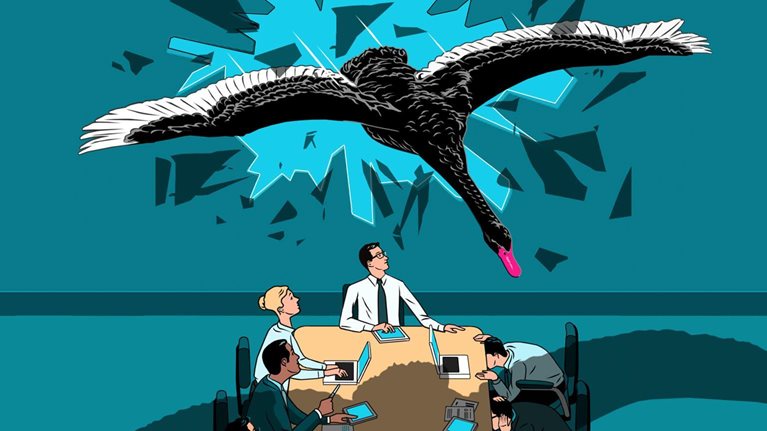
Are you prepared for a corporate crisis?

Nonfinancial risk today: Getting risk and the business aligned

Home | Online Store | Demo | Forum | Site Map

- How to Identify Critical Risks
- Blog: Project Management and Project Risk Analysis

The goal of risk analysis is to identify critical risks: those risks that have the most potential to positively or negatively impact your project objectives. Identifying critical risks is a process of prioritization and this an output of qualitative or quantitative risk analysis. Risk prioritization facilitates project decisions, particularly with regards to risk mitigation and response planning. There are a number of tools which can help with risk prioritization, particularly the risk register and the risk matrix.
Why We Should Prioritize Risks
Let us assume that this summer you are planning a road trip from Boston to New York that will primarily travel along the I95. The weather forecast is promising, nothing spectacular, but good for travelling. Before embarking on your trip, you perform an-hoc risk assessment. Like a good project manager, you want to minimize the chance of delays and determine what you might require in case of an emergency. Here is an example of risks that you might encounter:
- You run out of gas and your trip could take a lot longer. This is could be especially concerning if you find yourself out of gas while on the I95 as this means that you will have increased probability of other risks occurring as you are stranded precariously on the side of the freeway. Mitigation plan: Start with a full tank of gas and, if you are extremely risk averse, you might choose to carry an extra gas caner or two.
- Your car breaks down. As with the above, this has the potential to seriously impact your schedule (as well as your budget). Mitigation plan: Perform all scheduled maintenance and perhaps ask your mechanic to inspect all major systems. However, even a well maintained vehicle can suffer a breakdown, so you may want to carry a few spare parts. For example, some light bulbs, spark plugs, a crankshaft, and an alternator, just in case.
- You get a flat tire. You already have a spare one, but you could get a second flat. Mitigation plan: Carry a second spare tire.
- In spite of the forecast, the weather is unpredictable and may turn for the worst. Mitigation plan: Pack some extra supplies, candles, warm blankets, rain gear, extra food and other items that will help you survive a couple days in case of a major hurricane and floods. Take a raft and life jacket.
- You could be robbed. Could it happen on your way to New York? Absolutely. Mitigation plan: Wear body armor and carry your stun gun, pepper spray, and horn with you. Just in case things get really ugly, you probably should have your machine gun and enough rounds of ammunition of survive a long siege – think the “Walking Dead”.
- The roads could be blocked. Think of what happened to the King of France, Henry the IV. Well travelling down a road, he found it blocked by several logs. When they stopped, an assassin jumped into the carriage and stabbed the king. Henry IV was not good in risk management, but you are. Mitigation plan: Take a chainsaw and, just in case, your mother-in-law can ride in the back as a body guard.
- You could get a speeding ticket. You could go the speed limit and eliminate the risk altogether, but your plan calls for a speed of 15% over the posted limit. It will get you to New York quicker, but close to a speed that will put you at risk for a ticket. Mitigation plan: You could buy some anti-radar devices, but better yet, you can install stealth technology and your car invisible to police radar.
You might be starting to see a problem here. If you try to avoid and/or mitigate all of the risks you have identified, this will result in two things. Your car will be so laden down with supplies it will be unable to move and the expense of all your mitigation efforts will mean that you won’t have any funds to enjoy the sites if you manage to get to New York. For example, though we haven’t checked, we believe stealth technology would take a considerable chunk out of your budget. The reality is that you must deal with constrained resources (budget, time, etc.) and it would be impossible to completely mitigate all of your risks. The solution is to prioritize your risks to determine which are the most important, so that given your limited resources you can minimize your risks in the most cost effective manner possible. Now, the question is, how do you determine what risks are the most important? This is where the risk register comes in as it is the key to prioritizing your risks.
Risk scores
We discussed risk registers when we talked about risk identification. Now, we can use the risk register as part of the risk analysis, including risk response planning, and risk monitoring and control. To prioritize risks, you need to assign each one a risk score. The risk score is calculated using a risk’s probability and impact.
Risk score = Risk Probability * Risk Impact
If a risk occurs, it will have varying impacts on different project objectives (such as duration, cost, and safety). For example, the risk “run out of gas” may have a significant impact on your trip duration, but very little on cost or safety. Therefore, the risk score should be calculated separately for each objective. If you calculate the all probabilities and impacts of a risk, you can calculate its overall risk score. Table 1 shows an example of the risk register with risk scores calculated based on overall probabilities and impacts. The bar on the right column is an easy way to present risk scores. To make the score easier to understand, you can multiply them by a certain value (e.g. 100). Please note that risks in the risk register are sorted based on risk score. As a result, Table 1 is a tornado diagram for risk scores.
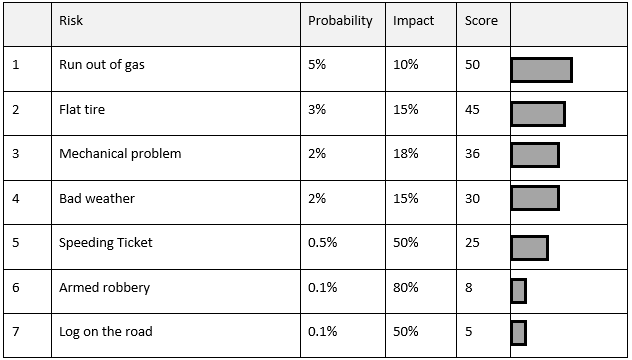
Risk scores relatively simple and yet powerful indicator of the order in which we should prioritize our risk response planning activities. Done properly, it provides a realistic measure of the potential impact and it relative importance as compared to other project risks. There are many cases in projects where a risk’s impact is very significant but the probability of occurring are very small. Psychologically, people overestimate the “score” of risks very high because the impacts arouse emotions like fear and anxiety. The classic situation is the risk of a terrorist attack on an aircraft. Although the impact of the risk can be very significant, the probability is very small. The score of a risk “terrorist attack” is lower than many other risks related to the operation of aircraft, such as mechanical problems or a sleep deprived pilot. As a result, people often support greater expenditure towards the elimination of terrorist attacks as opposed to improving maintenance programs or monitoring sleep diaries of pilots. In our road trip example, though an armed robbery would have a significant impact on our project, the probability of it occurring is extremely low. Therefore, its overall risk score is lower compared to the other risks. If you have to make a choice between bringing extra rain gear or wearing body armor, rain gear should be your priority. In this way we can see how accurate risk scores are the key to prioritizing your risks and making the best use of your limited resources.
Not finding what you are looking for?
- Chat with us!
- Culture and Business Transformation
7 key types of business risk every leader should plan for (2024 update)
- August 23, 2024
3. Compliance risk
How familiar are you with the laws and regulations that apply to your business? Compliance can be tricky for many reasons. Compliance risks represent a critical challenge for businesses operating in today’s highly regulated environment. Failure to adhere to industry regulations, data protection laws, and corporate governance standards can have significant legal and financial consequences. Non-compliance may lead to hefty fines, legal battles, and damage to a company’s credibility.
Recently, the Ministry of Manpower (MOM) in Singapore introduced the Complementary Assessment Framework (COMPASS) , which requires employers to offer clear career development pathways for foreign employees. This underscores the importance of businesses understanding and navigating these evolving regulations. To mitigate compliance risks related to COMPASS, it is crucial to implement robust employment verification strategies, including thorough background screening and employment history checks, ensuring adherence to current and new regulatory requirements.
4. Financial or economic risk
Financial or economic risk is closely related to business profits, so investors and shareholders often scrutinise it. Financial risks are caused by multiple factors, such as market movements, foreign currency exchange rates, commodity price fluctuations, etc. Strategies to mitigate financial or economic risk usually aim to ease cash flow issues, and common tactics include getting insurance, diversifying income streams, and limiting the amount or tenure of loans.
5. Reputational risks
Reputational risk involves the potential damage to a company’s public image and brand value, which can arise from various incidents, including unethical breaches, product failures, or poor customer service. Social media exacerbates this risk by amplifying the impact of any negative event. For instance, in 2017, United Airlines faced a severe reputational crisis when a video of a passenger being forcibly removed from an overbooked flight went viral. This incident led to widespread media condemnation and public outrage, significantly damaging the airline’s reputation. In such a highly connected environment, even a single misstep can quickly escalate, underscoring the importance of proactive reputation management.
6. Geopolitical risks
Geopolitical risks can significantly impact supply chains, as political instability, trade disputes, and international sanctions disrupt the flow of goods and materials across borders. The ongoing conflict between Russia and Ukraine serves as a stark example of such disruptions. The war has severely affected global supply chains , particularly in sectors reliant on key exports like grain and energy. For instance, companies worldwide have faced shortages and price increases for agricultural products due to the blockade of Ukrainian ports and the destruction of infrastructure. Additionally, disruptions in energy supplies from Russia have led to increased costs and supply uncertainties for industries dependent on natural gas and oil.
7. Hiring risk
When hiring, one of the most critical risks businesses face is the potential for hiring the wrong person, which can lead to significant consequences. A notable example of this risk is the case of a Nanyang Technological University (NTU) dropout who forged a bachelor’s degree in engineering and deceived companies, securing positions in The Walt Disney Company, Marshall Cavendish, and Scholastic Education International. It is shocking easily to get a fake university degree, a recent investigation by a Singapore news media reported.
Organisations can protect themselves from potential financial losses, reputational damage, and operational disruptions by ensuring candidates’ authenticity and qualifications.
How to minimise business risk
To effectively manage risks and ensure long-term stability, organisations must work towards getting the basics of risk management strategies right . Some essential actions include:
- Establish a comprehensive risk management framework that integrates risk identification, assessment, and mitigation processes across all levels of the organisation.
- Monitor and review your risk management strategies to adapt to evolving risks and ensure your controls remain effective.
- Cultivate a risk-aware culture by promoting clear communication, ongoing training, and accountability among all employees.
- Conduct background checks on potential employees.
Understandably, most businesses don’t have the time, know-how, and manpower to dedicate to thorough intelligence gathering. There’s also the grey area of privacy laws to consider – how much is a company allowed to dig into their potential hires or partners? In such cases, trusting a specialist and market leader like RMI to do the legwork for you can be the most cost-effective solution. Contact us to learn more about our solutions.
Proudly a member of

Preferred partners

Risk Management Intelligence 20 Anson, Road #19-01 Twenty Anson, Singapore 079912 Company Reg No: 201210650Z
- +65 6309 1800
- [email protected]
© RMI - All Rights Reserved 2024. Site by Manning&Co.
Quick links
Get the latest insights.
- Starting a Business
- Growing a Business
- Small Business Guide
- Business News
- Science & Technology
- Money & Finance
- For Subscribers
- Write for Entrepreneur
- Tips White Papers
- Entrepreneur Store
- United States
- Asia Pacific
- Middle East
- United Kingdom
- South Africa
Copyright © 2024 Entrepreneur Media, LLC All rights reserved. Entrepreneur® and its related marks are registered trademarks of Entrepreneur Media LLC
Business Plan Risks How to present your business risks without scaring away investors
By Stever Robbins Dec 11, 2004
Opinions expressed by Entrepreneur contributors are their own.
Q: I would like to include a risk analysis in my business plan. I don't know how to show risks without sending investors into an anxious frenzy.
A: Any start-up idea will have enough risk to fill a dozen business plans. No investor expects a risk-free plan. Angels and VCs know start-ups are incredibly risky. If they don't, don't take their money--they don't know what they're doing! Most projects fail for reasons that could have been (and sometimes were) predicted far in advance. Since entrepreneurs are optimistic folks by nature: They tend to brush off predictions of doom and charge ahead assuming they will find a way to overcome. You can often avoid the most dire scenarios with intelligent upfront risk planning.
The risk analysis in your plan is to show that you've thought through risks, that you know how to plan for probable risks, and that your plan can survive when things go wrong.
Your plan can address several kinds of risk. You don't need to address every kind of risk in the book, but pick the risk categories that are most relevant to your company and include a paragraph or two about each:
- Product risk is the risk that the product can't be created. Biotech firms often have a high degree of product risk. They never know for sure they can produce the drug they are hoping to produce.
- Market risk is the risk that the market will develop differently than expected. Sometimes markets take too long to develop, and cash runs out while a company is waiting for customers.
- People risk is big in companies that depend on having certain employees or certain kinds of employees. I was with a company that had hired one of the world experts in a certain type of 3-D modeling. It was possible that without this man on board and happy, the company wouldn't be able to create their product.
- Financial risk is the risk that a company will run out of money or mismanage their money in some way. Finance companies may have huge financial risk, since bad lending policies combined with poor investment policies can sink them.
- Competitive risk is the risk that a competing product or service will be able to win. Many Web-based businesses have high competitive risk since they can be started with little money and have no way of locking in customers.
What investors want is to know that you are prepared to respond to risks. To the extent possible, outline what your response is to the risk you anticipate. After all, assuming you get funding, those risks may really come to pass. And you will really have to do something about it. By showing investors some of the alternatives you've thought through, you raise their confidence that you'll be able to deal if things don't go according to plan.
For example, consider the risk to a restaurant that people won't come back. What are the reasons you believe that would happen? What can you do to keep that from happening in the first place? It amazes me how many restaurants have a lousy menu selection or bad food and go under without ever asking customers, "Did you enjoy your meal? What could we do to make it better?" An at-the-table survey may be how you propose to avoid having the wrong menu. If things go wrong, you may decide to proactively invite critics to the restaurant for specific feedback on how to make the experience better.
The key is acknowledging that things can go wrong and demonstrating some creativity in finding a solution. You certainly needn't respond to every risk imaginable. Your goal is to provide enough to help your investors feel secure that you have anticipated and dealt with major risks, and they can count on you to handle things that come up once the business is under way.
Stever Robbins is a consultant specializing in mastering overwhelm, power and influence. The author of It Takes a Lot More Than Attitude...to Lead a Stellar Organization , he has been a team member or co-founder of nine startups, an advisor and angel investor, and co-developer of Harvard's MBA program. You can find his other articles and information at SteverRobbins.com .
This article originally appeared on Entrepreneur.com in 2002.
Stever Robbins is a venture coach, helping entrepreneurs and early-stage companies develop the attitudes, skills and capabilities needed to succeed. He brings to bear skills as an entrepreneur, teacher and technologist in helping others create successful ventures.
Want to be an Entrepreneur Leadership Network contributor? Apply now to join.
Editor's Pick Red Arrow
- She Started a Business When She Couldn't Satisfy a European Craving in the U.S. — and It Made More Than $30 Million Last Year
- Lock Use This 'Simple Yet Timeless' Career Advice That Will Change Your Outlook on Career Advancement
- How to Overcome Imposter Syndrome and Start a Business, According to Gary Vee, a Serial Entrepreneur Worth Over $200 Million
- Lock Most People Hate This One Leadership Style — Here's How to Avoid It
- An Iconic McDonald's Treat Is About to Get a Makeover — Here's What to Expect
- Lock Is Your Co-Worker a 'Workplace Catfish'? An Expert Explains How to Uncover the Truth — Before You Pay the Price.
Most Popular Red Arrow
6 ways automation can eliminate your company's compliance risks.
Leverage automated systems to track, monitor and complete regulatory and compliance tasks.
At 24, She Was Fired From Her Advertising Job. Then an 'Incredibly Important' Mindset Helped Her Build a Multimillion-Dollar Business.
Melissa Ben-Ishay's brother Brian Bushell encouraged her to follow her passion — and it led to major success.
Mark Zuckerberg Uses an Easy But Powerful Formula to Keep Facebook Relevant — Here's How It Works
Zuckerberg says Meta never thought small, even in the early days when it was just Facebook.
How CEOs Can Find Their Leadership Style
Understanding these best practices and common pitfalls can help you find and develop your leadership style.
Why AI is Your New Best Friend... and Worst Enemy in the Battle Against Phishing Scams
As AI supercharges phishing tactics, businesses must upgrade defenses beyond spotting bad grammar or sloppy emails.
Crack the Chicken-and-Egg Dilemma — How Startups Can Thrive Against the Odds
Focus on one side of your marketplace first, build value for sellers or buyers and the other side will follow.
Successfully copied link

Associate Director, Access & Reimbursement RLT - San Diego, CA - Remote
About the role.
Key Responsibilities:
- Interact with large, complex accounts to support patient access within their aligned therapeutic area product(s), proactively provide face-to-face education on programs to providers and staff in order to support integration of those products into office processes and workflows.
- Address customer questions for issues related to NPC policies on therapeutic area products ordering, payment, inventorying, and product returns & replacement in offices.
- Work with key members of therapeutic area offices (e.g., executives, providers, administrators, billing and coding staff, claims departments, revenue cycle managers) in order to appropriately support patient access to products.
- Ability to analyze problems and offer solutions. Understand specifics and support questions associated with patient reimbursement and coordinate on reimbursement issues with third party payers at the provider-level. Analyze account reimbursement issues & opportunities (as needed). Identifies trends at a local, regional and national level and partner with purpose internally and externally to support patient pull-through.
- Supports pull through on local coverage decisions to enable meaningful patient access within the system. Proactively communicate policy changes or issues that could potentially affect other departments.
- Accountable for informing customers on NVS-sponsored patient support programs to enable patients starting and staying on therapy (i.e., Co-pay).
- Maintain expertise in regional and local access landscape, anticipating changes in the healthcare landscape, and act as their aligned therapeutic area product(s) reimbursement expert (as needed).
- Collaborate with aligned cross-functional associates within NPC (see above) to share insights on customer needs and barriers for their aligned therapeutic area product(s) related to access and reimbursement; Interface with Patient Support Center (hub) and Access & Reimbursement Managers on important matters related to patient case management, including tracking cases, issue resolution, reimbursement support, and appropriate office staff education.
- Maintain a deep understanding of NPC policies and requirements and perform all responsibilities with integrity and in a manner consistent with company guidance and prescribed Values and Behaviors. Handle Patient Identifiable Information (PII) appropriately (understand and ensure compliance with HIPPA and other privacy laws and regulations and internal Company compliance guidelines).
Buy and Bill Specific
- Assess access situation within the assigned geography and develop appropriate Plan of Action (POA). Communicate POA to appropriate personnel.
- Responsible for establishing preferred acquisition pathways. Educate on and support buy-and-bill end-to-end processes, workflows, and facility pull-through in complex accounts, including scenarios of centralized and decentralized acquisition, and use of alternative channels such as white bagging, clear bagging, brown bagging, and alternate site of care for administration.
- Educates relevant stakeholders on logistics related to ordering, payment, inventory, and product returns & replacement.
- Analyze reimbursement issues & opportunities, anticipating changes in the healthcare landscape, and act as the designated reimbursement expert for offices and field teams.
- Accountable for engagement with non-prescribers, for example pharmacy, system leadership, financial counselors, office administrators, revenue cycle managers, etc.
Radioligand Therapies Specific
The ADAR will be a critical partner to the Novartis Patient Support (NPS) customer engagement team on supply capacity, site procurement eligibility, as well as a customer facing resource for communications on orders and logistics.
- Understand RLT key priorities in core disease areas, financial goals, and site initiatives to influence overall account and regional business strategies.
- Assess and understand site and/or other appropriate organizations’ level of readiness for procurement of nuclear medicines and billing to facilitate orders for products and so that they can engage and educate on procurement systems and processes, access, and reimbursement. Be able to understand where gaps in procurement exist and work with Cross-Functional partners to resolve.
- Partner with the customer engagement teams to assist the communication and facilitation of procurement and logistics with both the site and the local field teams. (e.g., procurement, logistics processes and timing) as well as patient-specific support (benefit verification, PA and appeals and copay programs)
- Major accountabilities apply to therapy, diagnostic and theragnostic treatment centers.
What You’ll Bring to the Role:
Education: Bachelor’s degree required; Business and/or biological science education preferred. Advanced degree preferred.
Essential Requirements:
- 5+ Years of experience in pharmaceuticals / biotech industry focused in Patient Services, Market Access, Sales, and/or account management. With 2 of those years being in a Patient Services practice support role for a specialty product(s).
- Experience working with highly complex practices and/or health systems to establish access and acquisition pathways.
- Strategic account management experience using a proactive approach to anticipate access hurdles impacting accounts and patient access.
- Deep expertise and experience integrating manufacturer-sponsored patient support programs.
- Experience with specialty products acquired through Specialty Pharmacy networks.
- Knowledge of reimbursement pathways (specialty pharmacy, buy-and-bill, retail)
- Possess a strong understanding of Commercial payers, Medicare plans and state Medicaid in geographic region.
- Must live within assigned territory; Ability to travel and cover geography, at least 50% travel required, based on geography and territory / targeting make up.
Desirable Requirements:
- Experience leading and delivering presentations to C-level account executives.
- Strong ability to work cross functionally with such functions as Field Sales, Marketing, Market Access, Public Affairs, State & Government Affairs, Trade, Specialty Pharmacy Account Management, and applicable third-party affiliates.
- Expertise in therapeutic area practice dynamics and common reimbursement and product program support-related needs. Such as Oncology, Prostate Cancer or Nuclear Medicines
- Strong capabilities in the areas of customer focus, collaboration, business acumen, communication, and presentation skills.
Novartis Compensation and Benefit Summary : The pay range for this position at commencement of employment is expected to be between $174,400 and $261,600/year; however, while salary ranges are effective from 1/1/24 through 12/31/24, fluctuations in the job market may necessitate adjustments to pay ranges during this period. Further, final pay determinations will depend on various factors, including, but not limited to geographical location, experience level, knowledge, skills and abilities. The total compensation package for this position may also include other elements, including a sign-on bonus, restricted stock units, and discretionary awards in addition to a full range of medical, financial, and/or other benefits (including 401(k) eligibility and various paid time off benefits, such as vacation, sick time, and parental leave), dependent on the position offered. Details of participation in these benefit plans will be provided if an employee receives an offer of employment. If hired, employee will be in an “at-will position” and the Company reserves the right to modify base salary (as well as any other discretionary payment or compensation program) at any time, including for reasons related to individual performance, Company or individual department/team performance, and market factors.
Field roles with a dedicated training period only:
The individual hired for this role will be required to successfully complete certain initial training, including home study, in eight (8) or fewer hours per day and forty (40) or fewer hours per week.
Driving is an essential function of this role, meaning it is fundamental to the purpose of this job and cannot be eliminated. Because driving is an essential function of the role, you must have a fully valid and unrestricted driver’s license to be qualified for this role. The company provides reasonable accommodations for otherwise qualified individuals with medical restrictions if an accommodation can be provided without eliminating the essential function of driving.
Why Novartis: Helping people with disease and their families takes more than innovative science. It takes a community of smart, passionate people like you. Collaborating, supporting and inspiring each other. Combining to achieve breakthroughs that change patients’ lives. Ready to create a brighter future together? https://www.novartis.com/about/strategy/people-and-culture
Join our Novartis Network: Not the right Novartis role for you? Sign up to our talent community to stay connected and learn about suitable career opportunities as soon as they come up: https://talentnetwork.novartis.com/network
Benefits and Rewards: Read our handbook to learn about all the ways we’ll help you thrive personally and professionally: https://www.novartis.com/careers/benefits-rewards
EEO Statement:
The Novartis Group of Companies are Equal Opportunity Employers who are focused on building and advancing a culture of inclusion that values and celebrates individual differences, uniqueness, backgrounds and perspectives. We do not discriminate in recruitment, hiring, training, promotion or other employment practices for reasons of race, color, religion, sex, national origin, age, sexual orientation, gender identity or expression, marital or veteran status, disability, or any other legally protected status. We are committed to fostering a diverse and inclusive workplace that reflects the world around us and connects us to the patients, customers and communities we serve.
Accessibility & Reasonable Accommodations
The Novartis Group of Companies are committed to working with and providing reasonable accommodation to individuals with disabilities. If, because of a medical condition or disability, you need a reasonable accommodation for any part of the application process, or to perform the essential functions of a position, please send an e-mail to [email protected] or call +1(877)395-2339 and let us know the nature of your request and your contact information. Please include the job requisition number in your message.


IMAGES
VIDEO
COMMENTS
In this part of the business plan for each risk area and indicator, try to standardize all possible actions. ... This tool is a systematic approach to understanding the specific business risk and benefits associated with a decision, process, or project. 9. Cost-Benefit Analysis ... Here are some critical steps to consider: Risk avoidance: Some ...
Business Plan 101: Critical Risks and Problems. When starting a business, it is understood that there are risks and problems associated with development. The business plan should contain some assumptions about these factors. If your investors discover some unstated negative factors associated with your company or its product, then this can ...
1) Economic Risks. Failure to acquire adequate funding for your business can damage the chances of your business succeeding. Before a new business starts making profits, it needs to be kept afloat with money. Bills will pile up, suppliers will need payments, and your employees will be expecting their salaries.
Risk controls are measures taken to identify, manage, and eliminate threats. Companies can create these controls through a range of risk management strategies and exercises. Once a risk is identified and analyzed, risk controls can be designed to reduce the potential consequences. Eliminating a risk—always the preferable solution—is one ...
The risks and mitigants subsection is at the end of the strategy section of your business plan, at which point the reader has a fairly clear idea of what your business does, what market you operate in and what your strategy to conquer that market is. When writing this section, it's important to be transparent.
Here are several types of business risks to look for as you evaluate a company's standing: 1. Compliance risk. A compliance risk is a risk to a company's reputation or finances that's due to a company's violation of external laws and regulations or internal standards. A compliance risk can result in a company paying punitive fines or losing ...
Lack of adequate financial resources is a very critical business risk that might make a business to close. In most cases, the business runs out of enough money; many customers are taking too long to pay up; unforeseen expenses and too much miscellaneous; accidents and costly financial mistakes could pose a very critical business risk to the ...
Reason #1: Firstly, they want to understand whether or not the key risks in your business are so fundamental to the investment proposition that it would prevent them from funding you. Some businesses are not at the right stage to receive external funding and placate funder concerns. These businesses are best off dealing with key risk factors ...
To manage building risk, and the risk to employees, it is important that organizations do the following: Make sure all employees know the exact street address of the building to give to a 911 ...
Strategic risks relate to a business's internal choices, such as product development routines, advertising, communication tools, sales processes, investments in cutting-edge technologies, and more. These examples all directly impact function, performance, and overall results. 2. External strategic risk factors.
Risk management is too often treated as a compliance issue that can be solved by drawing up lots of rules and making sure that all employees follow them. Many such rules, of course, are sensible ...
Outsource. 24. Loss of key skills. Use employee incentive or bonus schemes. Check pay reflects industry (going rate) Identify top performers and reward/offer incentives to stay. Remove hygiene factors e.g. poor parking, lack of flexible working. 25. Loss of political support.
4 Reasons Why Risk Management Is Important. 1. Protects Organization's Reputation. In many cases, effective risk management proactively protects your organization from incidents that can affect its reputation. "Franchise risk is a concern for all businesses," Simons says in Strategy Execution. "However, it's especially pressing for ...
In business, risks are factors that an organization encounters that may lower its profits or cause it to fail. Sources of risk can be external, such as changes in what consumers want, changes in ...
The risk factors section of the business plan should go beyond simply listing what might go wrong. Being aware of what could negatively impact the company is important, but the real value of ...
Step 1: Develop a solid risk culture. An essential component of any successful risk management plan is the establishment of strong risk culture. Risk culture is commonly known as the shared values, beliefs, and attitudes toward the handling of risks throughout the organization. It is the responsibility of senior management and the board of ...
How to Perform Root Cause Analysis. Step 1: Define the problem - In the context of risk analysis, a problem is an observable consequence of an unidentified risk or root cause. Step 2: Select a tool - 5 Whys, 8D, or DMAIC. 5 Whys involves asking the question "why" five times.
To change this picture, leadership must commit to building robust, effective risk management. The project is three-dimensional: 1) the risk operating model, consisting of the main risk management processes; 2) a governance and accountability structure around these processes, leading from the business up to the board level; and 3) best-practice crisis preparedness, including a well-articulated ...
Identifying critical risks is a process of prioritization and this an output of qualitative or quantitative risk analysis. Risk prioritization facilitates project decisions, particularly with regards to risk mitigation and response planning. There are a number of tools which can help with risk prioritization, particularly the risk register and ...
Assign responsibility for tasks. 5. Develop contingency plans. 6. Communicate the plan and train your staff. 7. Monitor for new risks. A risk management plan can help minimise the impact of risks that could weaken your cash flow or damage your brand. It will also help create a culture of sensible risk awareness and management in your business.
After the hottest summer on record in the Northern Hemisphere in 2023, 66% of those surveyed saw extreme weather as the biggest risk for 2024 and could get worse: Expected global economic losses by 2060 could be US$24.7 trillion due to weather-related losses. 2. Security and cyber incident risks. In today's digital landscape, security and ...
A: Any start-up idea will have enough risk to fill a dozen business plans. No investor expects a risk-free plan. Angels and VCs know start-ups are incredibly risky. If they don't, don't take their ...
Location: Remote Getting patients the medicines they need presents a series of complex challenges that can only be overcome with curiosity, determination and the support of a strong, united team. Join us and you can be part of that team. The Associate Director, Access & Reimbursement, Radioligand Therapy (RLT) is a remote/field-based role that covers the following states but not limited to ...